
- •Editorial Advisory Board
- •Table of Contents
- •Detailed Table of Contents
- •Preface
- •Applying Semantic Agents to Message Communication in E-Learning Environment
- •A Case Study on Scaffolding Adaptive Feedback within Virtual Learning Environments
- •Enhanced Speech-Enabled Tools for Intelligent and Mobile E-Learning Applications
- •Quasi-Facial Communication for Online Learning Using 3D Modeling Techniques
- •Using a User-Interactive QA System for Personalized E-Learning
- •A Methodology for Developing Learning Objects for Web Course Delivery
- •Compilation of References
- •About the Contributors
- •Index
280
Chapter 19
A Methodology for Developing Learning Objects for Web Course Delivery
Karen Stauffer
Athabasca University, Canada
Fuhua Lin
Athabasca University, Canada
Marguerite Koole
Athabasca University, Canada
ABSTRACT
This article presents a methodology for developing learning objects for web-based courses using the
IMS Learning Design (IMS LD) specification. We first investigatedthe IMS LD specification,determining how to use it with online courses and the student delivery model, and then applied this to a Unit of Learning (UOL) for online computer science courses. We developed an editor and runtime environment to apply the IMS LD to a UOL. We then explored the prospect for advancement of the basic IMS LD UOL. Finally, we discussed how to construct ontology-based software agents to use with the learning objects created with the IMS LD Units of Learning.
INTRODUCTION
There has been research effort directed far and wide towards defining learning objects, their standards, and building tools for developing webbased courses using learning objects with standards such as the IMS Learning Design (IMS LD) specification (Koper & Olivier, 2004; Paquette et al., 2005). However, at the time this research
was undertaken, in early 2004, locating a runtime environment for learning objects that would work with these standards was a much more difficult task. In the beginning of the project, we needed to determine how to create learning objects, what the granularity of the learning objects should be, how to fit these learning objects together to form units in a course, and how to actually create learning object files using the IMS LD specification.
Copyright © 2010, IGI Global, distributing in print or electronic forms without written permission of IGI Global is prohibited.
A Methodology for Developing Learning Objects for Web Course Delivery
The need to create a runtime environment for the learning objects was the next facet to consider. Finally, because intelligent search and selection capabilities are possible with learning objects, the question of how to use agents and ontologies with learning objects was studied.
The goal of this research was, therefore, to develop a methodology for developing Extensible MarkupLanguage-(XML)basedlearningobjects for Web-based courses using the IMS LD specification and to design a runtime environment for these learning objects. The contributions of this project are the following: developing the means of creating Web-based courses using learning objects at various levels of granularity, developing the means of delivering courses online using learning objects, and initially exploring agents and learning objects using ontologies.
This chapter addresses the process of developing this methodology from the research stages through to the development and implementation of the IMS LD units of learning (UOL). As well, thefinaldiscussionlooksathowthespecification used for the learning objects can be extended by using intelligent agents and more advanced levels of the IMS LD.
LITERATURE REVIEW
One of the greatest strengths for institutions using learning objects lies in sharing and reducing redundancy in the distance learning development effort. There are a variety of standards based on XML that involve various organizations and aspects of learning objects. The standards for interoperabilityhavebeenaddressedbytheShareable Content Object Reference Model (SCORM) (http://www.adlnet.gov/scorm/). The IMS Global Learning Consortium, Inc. (IMS) (http://www. imsglobal.org/) and CanCore (http://www.cancore.ca)lookafter cataloguinglearningobjectsfor searches. Organizations such as the Multimedia Educational Resource for Learning and Online
Teaching (MERLOT) (http://www.merlot.org/) and the Campus Alberta Repository of Educational Objects (CAREO) (http://www.careo.org/) address repository standards. Furthermore, the Learning Object Review Instrument (LORI) addresses learning objects evaluation to help users determine which ones are worthwhile and which ones are not (Nesbit & Li, 2004).
The IMS Learning Design specification was chosen for this project because it nicely addresses theissueofdefiningthelearningobjectfilesinits simplestformatatLevelAofthespecification.It also has the ability to expand to Levels B and C and offer many more interesting and interactive capabilities. Koper and Olivier (2004) describe the IMS LD UOL as containing the learning objects and services that are needed in the process of learning and teaching. At the time of the study, there were tools being developed to work with the IMS LD specification, with the most promising tools under development, specifically
CopperCore (http://coppercore.sourceforge.net/) and Reusable Learning Object Authoring and Delivery (RELOAD) (http://www.reload.ac.uk/). These tools are now available in stable release from these websites.
As well, the IMS LD can be enhanced with the
LearningObjectMetadata(LOM),definedbythe
Institute of Electrical and Electronics Engineers (IEEE)(http://ltsc.ieee.org/wg12/20020612-Final- LOM-Draft.html), to enable expansion of the specification for more advanced methodology using the created learning objects. The IMS LD specificationhasfuturedevelopmentpotentialin theintegrationofontologiesthroughtheW3CWeb Ontology Working Group (http://www.w3.org/ TR/owl-features/). This would allow the use of software agents in supporting both developers and learners (Koper & Olivier, 2004; Richards,
2002). Finally, using ontologies could provide the model of the conceptual structures of learning objects and Web courseware authoring (Aroyo,
Dicheva, & Cristea, 2002).
281
A Methodology for Developing Learning Objects for Web Course Delivery
mETHODOLOGY
Analysis and Design
TheIMSLDspecificationdescribesaunitofstudy whichdefinesthelearningactionsthatsatisfyany number of related learning objectives. The use of the IMS LD along with a runtime application is described as similar to HTML being recognized in a web browser (Tattersall et al., 2003). Also, the IMS LD describes how to structure the coursematerialstodefinetheroles,methods,and resources of the UOL (McAndrew et al., 2004). McAndrew et al. (2004) suggested that a method to template the basic IMS LD implementation would be useful, in that replicating methods for the required instructional design model could be created. This is the model that has been used for this project.
Learning objects that make up a UOL can vary widely in granularity. A top level learning object would be the UOL itself (either a unit or section) with finer granularity learning objects being contained within the UOL. Consequently, due to varying levels of supplied context, the learning objects that make up an IMS LD UOL will differ in their usefulness as reusable resources.
The steps for getting started, recommended in IMS (2003), provide detailed guidelines for the analysis and design phases of the IMS LD development. These phases include the use case narrative,the UnifiedModelingLanguage(UML)
ActivityDiagram,compositionofXMLdocument instance, and the required inclusion of resources using the IMS Content Packaging specification. The first step in the design of a learning design is the use case narrative (IMS, 2003).
Sincethereisonlyoneroledefined,thatofthe independent learner, the activities will not need to be sorted into separate role parts. The student can choose any, or all, of the activities related to the UOL. The activities that fall under the learning objectives are encapsulated so that learning activities that include learning objectives can
themselves be considered learning objects (and, therefore, can be reused outside of this instance of the IMS LD). All learning activities consist of elements within the IMS LD XML document and describe the various course items defined in the instructional design model in computer science courses at Athabasca University. These course items consist of the commentary, learning objectives, readings, exercises, answers to exercises, key terms, and unit activities (defined here as simple learning objects). In terms of learning objects, the UOL is itself a learning object. The UOL contains other learning objects in the form of both simple learning objects and more complex learning objects composed of learning objectives encapsulated with related course items, such as readings, exercises, answers, and simple learning objects.
The learning activities are then incorporated into the learning structures. Any simple learning objects added are further defined inside the environment’s container. The methods container defines how the learning structures are assigned to roles and acted out (IMS, 2003). This insures that the instructional design recommendations for computer science courses are being carried out at the content creation stage. The UML Activity Diagram for this is shown in Figure 1.
Creation of the XmL Document
The next step involves creating the XML document based on the narrative and UML diagram. The method element contains the play, act, and role parts. The act elements are run sequentially, with the role parts run in parallel. If there is more than one play element, they are run in parallel (such as when a course is running in both distance learning or blended delivery). Role parts are the links to the activity-structure, activity, or environment. An activity-structure is assigned to a role at a specific point in the learning process (IMS,
2003). In the case of the computer science course development, the assignment is predetermined to
282
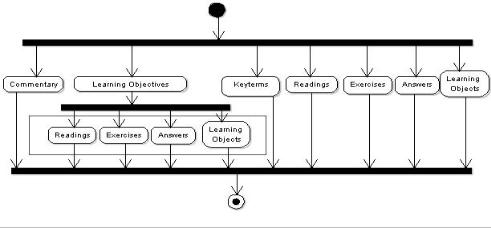
A Methodology for Developing Learning Objects for Web Course Delivery
Figure 1. UML activity diagram
be the individual learner. The components of the learning design are reusable, and to foster this reuse, references are used extensively, instead of nesting elements together. In creating the XML document for the course units of learning, the fixed methodology of online delivery to individualized learners determined the process of the design. Since the roles and methods are based on the independent learner, this allowed a standard definition for all the developed learning design documents. The methods container contains the entire UOL as the play, with the single role of individualized learner. This will be consistent from one UOL to the next, and therefore formed our template for creation of the rest of the IMS LD. Creating a UOL involved using this template to first generate the title for the learning design, and then determining the activities, activitystructures, and environments contained in the component container of the LD. The activities that are performed are any of the commentaries, readings, exercises, answers to exercises, or activities in the form of learning objects.
Once the IMS LD document was defined, the actualphysicalfilesneededtobereferenced.This was done by including the specification with the IMSContentPackagingSpecification. Thesetwo specificationsworktogetherwithinamanifestfile
to incorporate both a complex objectives-based learning structure, as well as the inclusion of the usable content (Stauffer, 2005).
Learning activities containing learning objectives are generally self-contained references to the items required for that learning objective. These could include readings, exercises, exercise answers, and learning objects (activities), and are definedintherecommendedinstructionaldesign at Athabasca University. Each learning activity that has learning objectives included is encapsulated so that it is potentially an individual learning object and can be displayed individually or reused. This has implications for future use of intelligent agents once the LOM metadata has been added. The lowest level learning objects are referenced as environment elements in the IMS LD. These learning objects will reside in the Digital Reading Room(http://library.athabascau.ca/drr)repository of the library of Athabasca University, which provides consistency and documentation of the learning objects, and improves their capability for reuse.
Development of the LmS Editor and
Runtime Environment
The IMS LD editor that was created for this project is a form-based servlet that creates the
283
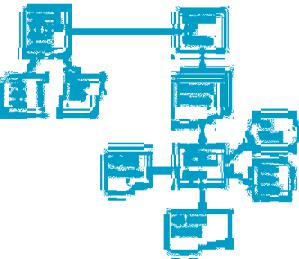
A Methodology for Developing Learning Objects for Web Course Delivery
Figure 2. System design flowchart
units of learning specific to Web-based courses. It was developed on a Linux platform using Apache/Tomcat Web services. The planning process overview of the system for the software project started with the design of the editor to createcoursefilesfromcourseitemsandlearning objects, and a runtime capable of displaying the files for the IMS LD UOLs. The UOL created by the editor can be validated with the CopperCore
API to ensure that it meets the IMS LD specification standards. The UOL is then passed to the Web server where the presentation of the UOL is looked after by Cascading Stylesheets (CSS) and Extensible Stylesheet Language Transformation (XSLT) stylesheets. Device detection is done at this stage to determine the device requirements for the stylesheets. Figure 2 shows the system design flowchart of this process.
The editor was designed to be a simple, formbased editor that would allow the user to input the items that make up a Web-based course. Instructional design considerations regarding the unit commentary, learning objectives, exercises, answers to exercises, and activities-based learning objects were all incorporated in the design of the editor and the runtime. The user interface was meant to be intuitive and easy to use, while
stillallowingenoughflexibilitytoadaptdifferent learning approaches in the development tool.
Since each UOL describes either a unit or section and is developed separately by the editor, one UOL can be run independently from others. The physical files in a UOL include the imsmanifest. xml Java Server Pages (JSP) files and related Extensible HyperText Markup Language (XHTML) filesforthatUOL.EachUOLiscontainedwithin its own separate directory. A course directory is also created to list the course units, but this directory does not include an imsmanifest.xml file and does not in itself become a UOL. The entire UOL is contained within a directory structure that contains the imsmanifest.xml fileandaccompanying resource files. Once the UOL is created and validated, it is then passed to the JSP/XSLT-based runtime environment. The runtime enforces the instructional design recommendations for computer science courses at Athabasca University. The visual design aspects of the UOL are handled within the CSS and XSLT stylesheets. The use of CSS and XSLT for presentation used with Java and JSP creates a dynamic presentation of the course content that allows for device detection for stylesheet determination.
284
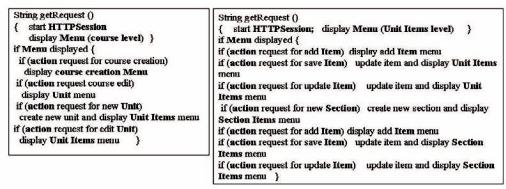
A Methodology for Developing Learning Objects for Web Course Delivery
Figure 3. Design for CreateUOL (Presentation Layer) and detailed design for UOL (Content Layer)
The development of the editor was separated into two implementations: content and presentation.Thepresentationlayeroftheeditorcreatesthe directoryandaddsthefilesandtitlestotheUOL.
The content layer then works directly on the XML development of the imsmanifest.xml file and the resourcefilesassociatedwiththeUOL.Becauseof this partition, the detailed design of both modules then involved separating the methods required to build the unit and section directories into the presentation level and the methods required to create the XML/XHTML into the content layer (UOL Servlet). The basic outline of the detailed design model can be viewed in Figure 3.
Exploring Ontologies and Agents with the ImS LD
Withthedevelopmentofcomputersciencecourses usingtheIMSLDspecificationandtheconcurrent development of learning objects, the potential is open for further advancements, such as the use of intelligent agents. There are constantly new technologies emerging for IMS LD, and many of these can be used to advance the basic IMS LD UOL developed with this project. This is discussed further in the discussion portion of this chapter.
RESULTS
The IMS LD editor and runtime are based on instructional and visual design recommendations for computer science courses at Athabasca University. (In 2007, this system is in full implementation for development and delivery of the study-guide-portion of the computer science course materials in the School of Computing and Information Systems at Athabasca University.) The resulting UOL is not readily adaptable for use outside of Athabasca University because it was developed using the instructional design model that is specific to the computer science courses.
The user is restricted to the documents allowed by the editor. However, because these documents arenotrestrictiveinthemselvesasXHTMLfiles, they can include any content type that is desired. There is also the ability to link to either outside learning objects or to upload other files locally, including HTML, graphics, program code, and other document formats. The display of other documents is handled by the browser and not the XSLT stylesheets.
The Editor
The actual editor is a simple, form-based web application. The user is given a series of menus for choosing a course to create or edit. The user then continues on to either create a new unit or
285
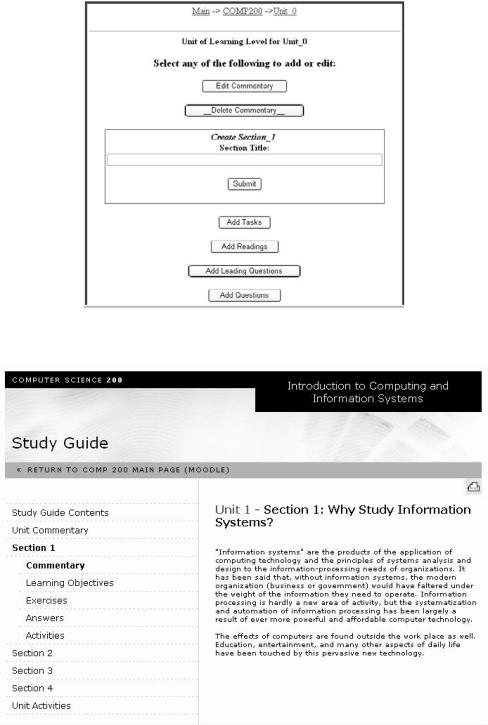
A Methodology for Developing Learning Objects for Web Course Delivery
Figure 4. Screen shot of IMS LD editor
Figure 5. Screen shot view of runtime sample
286
A Methodology for Developing Learning Objects for Web Course Delivery
select a unit to edit. All of the previous steps are part of the presentation layer of the servlet. Once inside the Unit level, the user is interacting with a unique UOL, and therefore is working within the content layer. Figure 4 shows a screen shot of the content layer at the Unit level in the IMS LD editor developed.
An Example
Computer Science 200: Introduction to Computing and Information Systems is a course at Athabasca University in Canada that is designed as a program introduction for computer science courses. Students in this course use a combination of locally-installed course materials, including an online textbook, and links to external sites. A numberofcourseenhancements,includingapplets and a software lab, are also part of the course materials. A working demonstration of the IMD LD editor is available at http://scis.athabascau. ca/servlet/lndse.createUOL. Figure 5 shows a screen shot of the runtime with Unit 1 – Section 1 learning objectives displayed.
DISCUSSIONS
There are constantly emerging new technologies for IMS LD and many of these can be used to advance the basic IMS LD UOLs developed with this project. The RELOAD editor can be used with the UOL files as a method to add Learning LOM to describe the various learning objects. The IMS
LD has place holders specified at different levels formetadataadditionusingtheLOMspecification
(IMS, 2003). This can occur from the top IMS LD element, down through to the lower level elements. In this way, the granularity of learning objects described by the LOM can include unit, section, learning-objectives-based and simple learning objects. Moreover, the LOM introduces nine categories of metadata and can be applied to each learning object in the IMS LD. In the case of
computer science courses, it would be beneficial to determine the learning objects with the greatest potential for reuse and apply the LOM metadata to these. This could be an entire unit or section, a subset of learning objectives, or a single simple learning object.
Protégé OWL and Ontology
Development
Qin (2003) createdan ontology tool thatrepresents the elements of the LOM and how they relate to each other (Qin & Hernandez, 2004). This tool also provides the full description of the classes and slots within each of the elements. The information derived from this documentation was valuable to this project, as it can be inserted into the Protégé Editor (http://protege.stanford.edu/) as the ontology representing the LOM.
The Protégé Editor also can be extended to include Java API plug-ins, specifically those to work in ontology development. The Ontology Bean Generator is one of these extensions. Its purposeistocreateJavaclassfilesthatcanbeused with the JAVA Agent DEvelopment Framework (JADE)environment (http://jade.tilab.com/).This requires adding the Ontology Bean Generator class and property files into the Protégé plug-in directory to load it into Protégé. Once in place, it can generate JADE-compliant Java classes that can be used in agent applications. The connection betweentheIMSLDUOLfilesandtheontology development using Protégé then becomes clear. The Ontology Bean Generator is used to create a groupofJavaclassfilesthatareJADE-compliant. ThegeneratedJavafilescanbeusedwithaJADE agent application to supply the ontology information between the agent application and the IMS
LD UOL files that have been enhanced with the LOM. The Java files created by the Protégé/
Ontology Bean Generator can be compiled and used with the classes of a JADE-based agent application.Eachclassfilerepresentsanelementof
287
A Methodology for Developing Learning Objects for Web Course Delivery
the LOM and has methods that represent the slots and relationships of each element class.
CONCLUSION AND FUTURE WORK
The use of the IMS LD to develop learning objects and UOLs for online courses has introduced some new possibilities for online course delivery. Enabling course creation using XML and IMS LD standards is a small step towards greater advancements in online learning systems. The course development process developed in this project separates the content of the course materials from the presentation, allowing the course materials the flexibility to be delivered to a variety of platforms and devices. Using the
IMS LD specification, with shareable content in the form of learning objects, enhanced with the possibility of ontology-based agents, may well provide a much more individualized approach to learning.
The editor and runtime can be enhanced to enable the richer content structure of the more complex IMS LD levels. In this project, we focused on only the Level A of the IMS LD. Future developments at this level can be enhanced to allow grouped and collaborative learning roles thatinteractatspecifiedpointsandwithspecified environmentsandservices.Furtherenhancements involvingthedevelopment ofmiddleware applications composed of intelligent agents would enable interaction with the learning objects metadata for searching and collecting appropriate objects, as well as delivering learning objects to the learner based on content requests and specifications.
ACKNOWLEDGmENT
We thank Daniel Burgos, Fred de Vries, Rob Koper,ColinTattersall,etalfromtheOpenUniversity of the Netherlands for their encouragement and great technical support.
REFERENCES
Aroyo,L.,Dicheva,D.,&Cristea,A.(2002,June).
Ontological support for Web courseware authoring. Paper presented at ITS 2002, the Proceedings of the 6th International Conference on Intelligent Tutoring Systems, San Sebastian, Spain.
IMS Global Learning Consortium, Inc. (2003).
IMS Learning Design Best Practice and Implementation Guide. Retrieved from http://www. imsproject.org/learningdesign/ldv1p0/imsld_ bestv1p0.html
Koper,R.,&Olivier,B.(2004).Representingthe learningdesignofUOLs.EducationalTechnology & Society, 7(3), 97-111.
McAndrew, P., Woods, W., Little, A., Weller, M.,
Koper, R., & Vogten, H. (2004). Implementing learning design to support Web-based learning.
Paper presented at The Tenth Australian World Wide Web Conference, Gold Coast, Australia.
Nesbit, J., & Li, J. (2004, July). Web-based tools for learning object evaluation. Paper presented at the International Conference on Education and Information Systems: Technologies and Applications, Orlando, FL.
Paquette, G., Marino, O., de la Teja, I., Léonard,
J.,Lundgren-Cayrol,K.,&Contamines,J.(2005).
Implementation and deployment of the IMS learning design specification. Canadian Journal of Learning and Technology, 31(2).
Qin, J., & Hernandez, N. (2004, May). Ontological representation of learning objects: Building interoperable vocabulary and structures. Paper presented at the Proceedings of the 13th international World Wide Web conference on Alternate track papers & posters, New York, NY.
Richards, G. (2002). Editorial: The challenges of the learning object paradigm. Canadian Journal of Learning and Technology, 28(3).
288
A Methodology for Developing Learning Objects for Web Course Delivery
Stauffer, K. (2005). XML, IMS LD, and learning object development for Web course delivery. Unpublished master’s thesis, Athabasca University, Athabasca, Alberta, Canada.
Tattersall, C., Manderveld, J., Hummel, H., Sloep,
P.,Koper,R.,&deVries,F.(2003).IMSLearning
Design Frequently Asked Questions. Educational Technology Expertise Centre. Retrieved from http://dspace.learningnetworks.org/retrieve/206/ IMS+Learning+Design+FAQ+1.0.pdf
This work was previously published in International Journal of Distance Education Technologies, Vol. 6, Issue 3, edited by Q. Jin, pp. 58-68, copyright 2008 by IGI Publishing (an imprint of IGI Global).
289
290
Chapter 20
A Chinese Interactive Feedback
System for a Virtual Campus
Jui-Fa Chen
Tamkang University, Taiwan
Wei-Chuan Lin
Tak Ming College, Taiwan
Chih-Yu Jian
Tamkang University, Taiwan
Ching-Chung Hung
Tamkang University, Taiwan
ABSTRACT
Considering the popularity of the Internet, an automatic interactive feedback system for E-learning websites is becoming increasingly desirable. However, computers still have problems understanding natural languages, especially the Chinese language, firstly because the Chinese language has no space to segment lexical entries (its segmentation method is more difficult than that of English) and secondly because of the lack of a complete grammar in the Chinese language, making parsing more difficult and complicated. Building an automated Chinese feedback system for special application domains could solve these problems. This paper proposes an interactive feedback mechanism in a virtual campus that can parse,understandandrespondtoChinesesentences.Thismechanismutilizesaspecificlexicaldatabase according to the particular application. In this way, a virtual campus website can implement a special application domain that chooses the proper response in a user friendly, accurate and timely manner.
Copyright © 2010, IGI Global, distributing in print or electronic forms without written permission of IGI Global is prohibited.
A Chinese Interactive Feedback System for a Virtual Campus
INTRODUCTION
The easiest way to communicate to users is to talk to them in their natural language. Considering the popularity of the Internet, an automated interactive feedback system for e-learning Web sitesisbecomingincreasinglydesirable.However, itstillisdifficultforacomputertounderstandthe meaning of some natural languages. At present a three-year old child can understand and respond to languages better than a computer can. To understand the natural language, a computer must be trained to understand a single sentence. Then, it would need to be trained to analyze longer sentences or paragraphs. In principle, there are at least two skills that a computer should be able to apply to a single sentence:
1.Defining the meaning of each word in the sentence.
2.Transforming the linear structure of a sentence into another structure that represents the meaning of that sentence.
ThefirststepofprocessingaChinesesentence is seeking the meaning of each lexicon in a dictionary. However, there can be many meanings for each lexicon, and the computer must have the ability to choose the right one. Even if that is accomplished,itisstilldifficultforthecomputer to process the Chinese sentence because there are no spaces used to segment the lexicon. Therefore, a segmentation method is needed before parsing the Chinese sentences.
The second step of understanding a Chinese sentence is transforming the segmented lexicons into a structure that can be understood by a computer. In general, the transformation procedure can be divided into three parts:
A.Syntactic analysis procedure: In this procedure, the input lexicon is transformed into a specific structure that represents the relationship between lexicons. However, not
allthecombinationsof lexiconsof asentence are legal. The computer must eliminate the illegal combinations to ensure a correct performance.
B.Semanticanalysisprocedure:Thisprocedure obtains the meaning of the sentence from the establishedstructure.Theobtainedmeaning is a unit of knowledge representation, which can be mapped to the corresponding object or event in the actual world.
C.Pragmatics analysis procedure: This procedure determines the real purpose of the sentencesandgivestheappropriateresponse to users.
The remainder of this paper is laid out as followed. The next section discusses the related works on syntax and semantic analysis, followed by a description of the proposed four subsystems of segmentation, syntactic analysis, semantic analysis, and the response subsystems. The next section provides some examples to show the implementation of the proposed method. Finally, there is conclusion and some future works.
REVIEW OF RELATED WORKS
Link Grammar Technology
Most sentences in a natural language are structured so that arcs that connect words may not cross each other. This phenomenon is called planarity in the link grammar system (Sleator &
Temperley, 1991). A link grammar consists of a set of words and has a linking requirement. The linking requirements of each word are contained in a dictionary. To illustrate the linking requirements, Figure 1 shows a simple dictionary for the words “a,” “the,” “cat,” “mouse,” and “chased.” The linking requirement of each word is represented by the Figure 1 above the word.
Each of the lettered boxes is a connector which is satisfied when it is “plugged into” a compat-
291
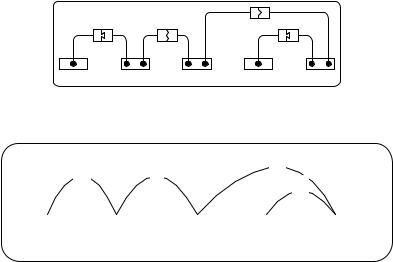
A Chinese Interactive Feedback System for a Virtual Campus
Figure 1. Words and connectors in the dictionary
|
|
|
O O |
|
D D |
|
S S |
|
D D |
the |
cat |
chased |
a |
mouse |
Figure 2. The simplified form of Figure 1
D |
S |
O |
|
D |
|||
|
|
||
The cat |
|
chased a mouse |
ible connector, as indicated by its shape. If the mating end of a connector is drawn facing to the right, then its mate must be to its right facing to the left. Exactly one of the connectors attached to a given black dot must be satisfied. Thus, the
“cat” requires a D connector to its left and either an O connector to its left or an S connector to its right. Plugging a pair of connectors together corresponds to drawing a link between that pair of words.
Figure2isthesimplifiedformofFigure1and shows that “the cat chased a mouse” is part of the language. Table 1 encodes the linking requirements of the example in Figure 2.
The link grammar dictionary consists of a collection of entries, each of which defines the linking requirements of one or more words.
These requirements are specified by a formula of connectors combined by the binary associative operators & and or. Precedence is specified by parentheses. A connector is simply a character string ending in + or -.
memory-Based Parsing System
Mostmethodsofsemanticanalysisfirstrecognize the verb of a sentence and then determine the
Table 1. The words and linking requirements in a dictionary
Words |
Formula |
|
|
a the |
D+ |
cat mouse |
D- & (O- or S+) |
Chased |
S- & O+ |
|
|
correctness on the semantics of lexical entries around the verb. Memory-based parsing (Chung,
& Moldovan, 1993, 1994a, 1994b; Kim & Moldovan, 1993) also begins with the restrictions of a verb to determine the correctness of subject and object. The memory-based parsing system consists of four modules:
•Concept sequence layer: Keeps the restrictions of the subject and object of each verb for both syntax and semantics.
•Syntactic layer: Keeps all parts of speech for comparing the syntactic restrictions.
•Semantic concept hierarchy: Defines the relationship of all nouns, and is used for verifying the semantic restrictions.
•Instance layer: Contains the lexical entries of a sentence typed by the user.
292
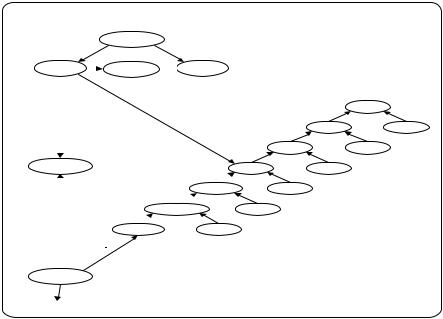
A Chinese Interactive Feedback System for a Virtual Campus
Figure 3. Part of knowledge base used for processing: “The Shining Path”
|
|
|
|
|
|
Concept sequence layer |
|
|
|
|
|
|
|
|
|
|
|
|
|
|
|
|
|
|
||||||||||||
|
|
|
|
|
|
|
[agent, MURDER, |
object] |
|
|
|
|
|
|
|
|
|
|
|
|
|
|
|
|
||||||||||||
|
|
|
|
|
|
|
|
|
|
|
|
|
|
murder-event |
|
|
|
|
|
|
|
|
|
|
|
|
|
|
|
|||||||
|
|
|
|
|
|
|
|
|
|
|
first |
|
|
|
|
|
last |
|
|
|
|
|
|
|
|
|
|
|
|
|
|
|
|
|
||
|
|
|
|
|
agent10 |
next |
MURDER10next |
object10 |
|
|
|
|
|
|
|
|
|
|
|
|||||||||||||||||
|
|
|
|
|
|
|
|
|
|
|
|
|
|
|
|
|
|
|
|
|
|
|
|
|
|
|
|
|
|
|
|
|
|
|
|
|
|
|
|
|
|
|
|
|
|
|
|
|
|
|
|
|
|
|
|
|
|
|
|
|
|
|
|
|
|
|
|
|
|
|
|
|
|
|
|
|
|
|
|
|
|
|
|
|
|
|
|
|
|
|
|
Semantic concept hierarchy |
|
|
|
|
is-a |
|
||||||||||||
|
|
|
|
|
|
|
|
|
|
|
|
|
|
|
|
|
|
|
|
|
|
|
|
|
|
|
|
|
|
|
|
|
|
thing |
||
|
|
|
|
syntactic |
|
|
|
|
|
|
|
|
|
|
|
|
|
|
|
|
|
|
|
|
|
|
is-a |
|
is-a |
|||||||
|
|
|
|
|
|
|
|
|
|
|
|
|
|
|
|
|
|
|
|
|
|
|
|
|
|
|
|
|
|
|
physical |
|
|
abstract |
||
|
|
|
|
|
|
|
|
|
|
|
|
|
|
|
|
|
|
|
|
|
|
|
|
|
|
|
|
|
|
is-a |
|
|
|
is-a |
|
|
|
|
Syntatic |
|
|
|
|
|
|
|
|
|
|
|
|
|
|
|
|
|
|
|
|
|
|
animate |
|
|
inanimate |
||||||||
|
|
|
layer |
|
|
|
|
|
|
|
|
|
|
|
|
|
|
|
|
|
|
|
|
|
|
|
|
|||||||||
|
|
|
|
|
|
|
|
|
|
|
|
|
|
|
|
|
|
|
|
|
|
|
|
|
|
|
|
is-a |
|
|
is-a |
|
|
|
|
|
|
|
|
noun-group |
|
|
|
|
|
|
|
|
|
|
|
|
|
human |
non- |
|
|
|
|||||||||||||||
|
|
|
|
|
|
|
|
|
|
|
|
|
|
|
|
human |
|
|
|
|||||||||||||||||
|
|
|
|
|
|
|
|
|
|
|
|
|
|
|
|
|
|
|
|
|
|
|
|
is-a |
|
|
|
|
is-a |
|
|
|
|
|||
|
|
|
|
|
|
|
|
|
|
|
|
|
|
|
|
|
|
|
|
|
hum |
an- |
|
|
|
person |
|
|
|
|
|
|
||||
|
|
|
|
|
|
|
|
|
|
|
|
|
|
|
|
|
|
|
|
|
|
group |
|
|
|
|
|
|
|
|
|
|||||
|
|
|
|
|
|
|
|
|
|
|
|
|
|
|
|
|
|
|
|
is-a |
|
|
is-a |
|
|
|
|
|
|
|
|
|
||||
|
|
|
|
|
|
|
|
|
|
|
|
|
|
|
|
|
|
|
|
|
|
|
|
|
|
|
|
|
|
|
|
|
||||
|
|
|
|
|
|
|
|
|
|
|
|
|
|
|
|
|
|
terro |
rism- |
|
|
|
|
|
nation |
|
|
|
|
|
|
|||||
|
|
|
|
|
|
|
|
|
|
|
|
|
|
|
|
|
|
organization |
|
|
|
|
|
|
|
|
|
|
|
|||||||
|
|
|
|
|
instance |
|
|
|
|
|
|
|
|
is-a |
|
|
|
|
is-a |
|
|
|
|
|
|
|
|
|
|
|
|
|||||
|
|
|
|
|
|
|
|
|
|
|
shining |
|
|
|
FXLM |
|
|
|
|
|
|
|
|
|
|
|
||||||||||
|
|
|
|
|
|
|
|
|
|
|
|
|
|
|
|
path |
|
|
|
|
|
|
|
|
|
|
|
|
|
|
||||||
|
|
|
|
|
|
|
|
|
|
|
|
|
|
|
|
|
|
|
|
|
|
|
|
|
|
|
|
|
|
|
|
|
|
|||
|
|
|
|
|
|
|
|
|
|
|
|
|
|
|
|
|
|
|
|
|
|
|
|
|
|
|
|
|
|
|
|
|||||
|
|
Instance |
|
|
|
|
instance |
|
|
|
|
|
|
|
|
|
|
|
|
|
|
|
|
|
|
|
||||||||||
|
|
|
layer |
|
|
|
|
|
|
|
|
|
|
|
|
|
|
|
|
|
|
|
|
|
|
|
|
|
|
|
|
|
||||
|
|
|
|
|
|
|
|
|
|
|
|
|
|
|
|
|
|
|
|
|
|
|
|
|
|
|
|
|
||||||||
|
|
|
shining-path#1 |
|
|
|
|
|
|
|
|
|
|
|
|
|
|
|
|
|
|
|
|
|
|
|||||||||||
|
|
|
|
|
|
|
|
|
|
|
|
|
|
|
|
|
|
|
|
|
|
|
|
|
|
|
|
|
|
|
|
|
||||
|
|
|
|
|
|
lexical |
|
|
|
|
|
|
|
|
|
|
|
|
|
|
|
|
|
|
|
|
|
|
|
|
|
|
|
|||
|
|
|
|
|
|
|
|
|
|
|
|
|
|
|
|
|
|
|
|
|
|
|
|
|||||||||||||
“the shining path” |
|
|
|
|
|
|
|
|
|
|
|
|
|
|
|
|
|
|
|
|
|
|
||||||||||||||
|
|
|
|
|
|
|
|
|
|
|
|
|
|
|
|
|
|
|
|
|
|
|
|
|
|
|
|
|
|
|
|
|
|
|
|
|
Figure 3 shows an example of a memorybased parsing with a concept sequence [agent, MURDER, object] for murder-event. At the top of the knowledge base is the concept sequence layer, which consists of concept sequence roots and elements.Thesemanticconcepthierarchyand syntacticlayerconnectconceptsequenceelements with concept instances in the instance layer. Concept instances are produced from phrasal inputs and are connected to the corresponding syntactic category and semantic concept nodes. The result of parsing is represented by connecting instances of concept sequence roots and corresponding concepts in the instance layer.
THE PROPOSED SYSTEm
Overview
There are many learners in a virtual campus, and each learner has his or her own preference. Although the search goal can be found by a belief network, as considered in customization, using
onlythedefaultcategorytoanalyzeisinsufficient.
When a learner logs onto a virtual campus, if he or she is an existing learner, the system could load hislearningprofiletoachievethecustomization.
If the learner is new, the system could administer aquiztodetermineaninitiallearningprofile.The flowchart is shown in Figure 4
The proposed Chinese interactive feedback system(Chen,Lin,&Jian,2003a,2003b,2003c; Chen,Lin,Jian,&Hung,2005)isdividedintofour sub-systems: the segmentation system, syntactic analysis system, semantic analysis system, and response system. Thus, learners can use Chinese sentences to interact with the virtual campus. When the learners input Chinese sentences, the segmentation system separates the learner’s input sentences and gives the appropriate part of speech for each segmented lexical entry. The syntactic analysis system parses these segmented lexical entries to judge whether the sentence is legal and gives the syntactic part of each lexical entry. The semantic analysis system judges the correctness of the semantics and provides a semantic learning method based on the learner’s habits. Finally, a
293
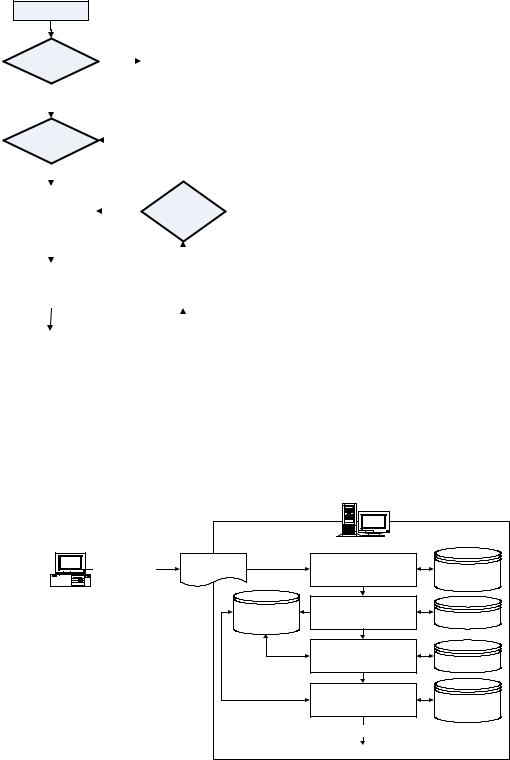
A Chinese Interactive Feedback System for a Virtual Campus
Figure 4. Flowchart of feedback system
User login
|
First login? |
|
|
|
|
|
|
|
Simple test |
|
||||||
|
|
|
|
Yes |
|
|
|
|
||||||||
|
|
|
|
|
|
|
||||||||||
|
|
|
|
|
|
|
|
|
|
|
|
|
|
|
|
|
|
|
|
|
|
|
|
|
|
|
|
|
|
|
|
|
|
|
|
NO |
|
|
|
|
|
|
|
|
|
|
|
|
||
|
|
|
|
|
|
|
|
|
|
|
|
|
|
|
|
|
|
Reasoning |
|
|
|
|
|
|
|
|
|
|
|
||||
|
system |
|
|
|
|
|
|
|
|
|
|
|
||||
|
|
|
|
|
|
|
|
|
|
|
|
|
|
|
|
|
|
|
|
|
|
|
|
|
|
|
|
|
|
|
|
|
|
|
|
|
|
|
|
|
|
|
|
|
|
|
|
|
|
|
|
Response |
|
|
|
|
|
|
|
User’ s |
|
||||||
suitable teaching |
|
|
|
|
|
|
|
|
||||||||
|
|
|
|
|
|
|
degree |
|
||||||||
|
material |
|
|
|
|
|
|
|
|
|||||||
|
|
|
|
|
|
|
|
|
|
|
|
|||||
|
|
|
|
|
|
|
|
|
|
|
|
|
|
|
|
|
|
|
|
|
|
|
|
|
|
|
|
|
|
|
|
|
|
|
|
|
|
|
|
|
|
|
|
|
|
|
|
|
|
|
|
User learning |
|
|
|
|
|
|
|
|
User’ s profile |
|
|||||
|
|
|
|
|
|
|
|
|
|
|
|
|
|
|
|
|
|
|
|
|
|
|
|
|
|
|
|
|
|
|
|
|
|
|
|
|
|
|
|
|
|
|
|
|
|
|
|
|
|
|
|
User logout |
|
|
|
|
|
|
|
|
|
|
|
||||
|
|
|
|
|
|
|
|
Update |
|
|
|
|||||
|
|
|
|
|
|
|
|
|
|
|||||||
|
|
|
|
|
|
|
|
|
|
|
|
|
|
|
|
|
response system gives the learner the response result according to the encoding of the input sentence.
Segmentation System
One difference between the Chinese and English language is that the Chinese language has no obvious separation to segment the lexical entry. Therefore a segmentation method to parse the Chinese language is necessary. Figure 5 shows the architecture of the Segmentation System.
The segmentation system structure is divided into four sub-systems: the segmentation system, corpora-comparing system, keyword in context comparing system, and weighted calculation method (Chen, Lin, & Jian, 2003a). These subsystems are explained as follows:
1.Segmentation: Segmentation separates the user’s input sentences and compares the separated units with those obtained from the corpora-comparing system.
2.Corpora-comparing system: This system includes two steps: corpora-comparing and
Figure 5. The architecture of the segmentation system |
|
|
||
|
|
WWW Server |
|
|
Input Chinese |
HTML Page |
prehandle sentence |
|
|
segmenting lexical |
form word |
|||
Language |
|
|||
User's Client |
|
entries |
mark rule |
|
|
comparing corpora |
|
||
|
|
|
||
|
Segmentation |
record POS |
professional |
|
|
Tree |
establish Segmentation tree |
corpora |
|
|
|
|||
|
|
comparing with |
|
|
|
|
keyword in context |
grama rule |
|
|
|
Computing weight |
wordbuilding |
|
|
|
|
rule and |
|
|
|
Segmentation tree and results |
weight |
|
|
|
|
||
294

A Chinese Interactive Feedback System for a Virtual Campus
Figure 6. Segmentation system’s flow chart |
|
|
|
|
|
|||
|
|
|
N |
|
|
|
|
|
source |
special |
Y |
remove |
punctuation |
Y |
transform into |
form word |
|
|
chinese |
surplus / |
divide char. |
|
||||
|
|
|
|
|
|
|||
|
|
|
|
|
|
N |
|
Y |
|
|
|
|
|
N |
|
|
|
|
|
|
|
|
|
|
|
|
|
|
|
|
|
|
send |
insert divide |
N |
|
|
|
move pointer |
divide char. |
|
segmented |
|
|
|
|
|
|
char. |
|
|||
|
|
|
|
|
|
words |
|
|
|
|
|
|
|
|
|
|
|
part-of-speech(POS)saving.Itcomparesthe receiving strings with those in the corpora and saves the results to build a segmentation tree.
3.Keyword in context comparing system: After building a segmentation tree, the system compares the POS with the keyword in context according to the grammar rules and deletes the improper segmentation tree. This mechanism is divided into the Unknown Word Judgment System and Context-proofreading System.
4.Weighted calculation system: Because there may be more than one kind of segmentation result, each result’s weighted value is computed to find the most proper one. The segmentationresultwiththelargestweighted value is the most suitable result.
Segmentation
There is no space between lexical entries in the Chinese language to help segmentation. Chinese characters are composed of two continuous bytes in representation. The system judges whether this word is Chinese code when segmenting sentences to put the pointer’s displacement in the best place. However, in transmitting, some special Chinese words have a special \ inserted after transmitting through the network browser. The system would remove the \ prior to segmenting the sentences.
The main functions of the segmentation system are:
1.The consideration of special Chinese words in the user’s input sentences serves to avoid punctuation-transferring mistakes
2.The transfer of punctuation in the user’s input sentences serves to obtain the same dividing code. The system splits the continuous Chinese words and numbers them into strings and adds a dividing code both in front of and behind the strings. The system also adds a dividing code behind the empty word of the user’s input sentence. In addition the system also splits the user’s input sentence and compares the segmented lexical entries with the corpora-comparing system. Figure 6 shows the segmentation system process.
Most Chinese lexicons possess at most six characters. The segmentation length of a Chinese sentence should be limited to avoid segmenting a sentence into many impossible ways. For example, a sentence composed of n words should have 2n-1 possible segmentations. A maximum matching(Chen&Liu,1992)mechanismisused to segment a sentence. Basically, the maximum matching method compares a string started at the kthcharacterwithalexicaldatabaseandfindsout all possible segmentations. If C(k), C(k)_C(k+1), C(k)_C(k+1)_C(k+2) are stored in the lexical database, the maximum matching method would choose the longest wordandcontinuewithC(k+3). Because the length of most of the Chinese lexicons do not exceed six characters, the maximum length of a word in a sentence is set to six characters.
295
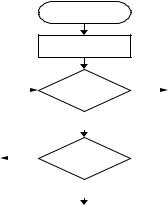
A Chinese Interactive Feedback System for a Virtual Campus
Table 2. Corpora data structure
Numbers of words |
Context |
POS |
Types |
Word frequency |
|
|
|
|
|
Figure 7. Unknown word judgment system process
string and pointer
i=1
|
|
|
|
|
|
|
i<= MaxLen |
|
|
|
|
return 0 |
|||
|
|
|
|
|
|
|
|
N |
|
||||||
|
|
|
|
|
|
|
|
|
|||||||
|
|
|
|
|
|
|
|
|
|
|
|
|
|
|
|
|
|
|
|
|
|
|
|
|
|
|
|
|
|
|
|
|
|
|
|
|
|
|
|
|
|
|
|
|
|
|
|
|
|
|
|
|
|
|
|
Y |
|
|
|
|
|
|
|
|
|
|
|
|
|
|
comparing |
|
|
|
|||||
i=i+1 |
|
|
N |
|
|
|
|
|
|||||||
|
|
|
|
success |
|
|
|
||||||||
|
|
|
|
|
|
|
|
|
|
||||||
|
|
|
|
|
|
|
|
|
|
|
|
|
|
|
|
|
|
|
|
|
|
|
|
|
|
|
|
|
|
|
|
|
|
|
|
|
|
|
|
Y |
|
|
|
|
|
|
|
|
|
|
|
|
|
|
|
|
|
|
|
|
|||
|
|
|
|
|
|
|
return ptr |
|
|
|
|
|
|||
|
|
|
|
|
|
|
|
|
|
|
|
|
|
|
|
Corpora-Comparing System
After the segmentation system separates the sentences, it compares string length and context. The system records all matching POSs and adds the information of the lexical entries to a segmentation tree. If no POSs match, the system feeds back a false value and recalls the unknown word judgment sub-system to determine whether this word is an unknown word. If the lexical entry is determined by the system to be an unknown word, then the entry is saved into the segmentation tree. Because most new unknown words are proper names, the system often sets the POSs of these unknown words to be temporary nouns, and continues processing the following set of strings.
If the system still cannot find the corresponding
POSinthecorpusdatabaseofonetosixcontinuous words or cannot find the proper unknown word after processing by the unknown word judgment system, it views these six continuous words as an unknown word and adds the unknown word into the segmentation tree.
The corpora structure used in the system is shown in Table 2. The saved data format contains the numbers of words, context, POS, types, and word probability. They are explained as follows:
A.Numbers of words: To speed up the comparing of the corpora, the information of the numbers of lexical entries are recorded so that the system does not have to search the entire database, greatly improving the efficiency of the system.
B.Context: Refers to the recorded context of the lexical entry.
C.POS: Records the POS of the lexical entry. If the number of the POS is larger than one, the system separates the sentence with “,” as a divided symbol.
D.Types: This paper is focused on mutual conversation segmentations in the basic computer concept domain. Therefore, the type is used to mark the kind of special domain database that is used for the lexical entry.
296

A Chinese Interactive Feedback System for a Virtual Campus
Figure 8. Segmentation tree structure
root
one-word |
|
two-word |
|
three-word |
|
four-word |
|
five-word |
|
|
six-word |
|||||||||||||||||||||||||||||
|
|
|
|
|
|
|
|
|
|
|
|
|
|
|
|
|
|
|
|
|
|
|
|
|
|
|
|
|
|
|
|
|
|
|
|
|
|
|
|
|
|
|
|
|
|
|
|
|
|
|
|
|
|
|
|
|
|
|
|
|
|
|
|
|
|
|
|
|
|
|
|
|
|
|
|
|
|
|
|
|
|
|
|
|
|
|
|
|
|
|
|
|
|
|
|
|
|
|
|
|
|
|
|
|
|
|
|
|
|
|
|
|
|
|
|
|
|
|
|
|
|
|
E.Word frequency: Shows how often the lexical entry has appeared in the equilibrium corpus database. The information is used primarily for weight calculation.
Unknown Word Judgment System
Thissystemsearchesthesegmentedlexicalentries for unknown words. After the system receives strings, it splits N continuous words continuously and compares them with the corpus database. If the proofreading is successful, the system feeds the first words of the lexical entry back to the position where the string engages. The system sets the string which is beyond the position of being an unknown word and saves it into a segmentation tree. If the system fails when compared, it feeds back 0 to show that this word is not an unknown word. Figure 7 shows the flow of the unknown word judgment system.
The Data Structure of the
Segmentation Tree Node
The system adds the segmented lexical entry into the segmentation tree to speed up node searching. The segmentation tree structure can make data saving more flexible by increasing or decreasing segmentationnodes.Thesegmentationtreeisasix node tree. The tree structure is shown in Figure 8. Every node in Figure 8 follows from zero to at most six sub-nodes which are added dynamically when compared with the corpora. The original
input sentence connects the first node of the root to the following branches. In this way the system can dispose of space dynamically to save and display the segmentation results.
Every node of the segmentation tree is composed of the following node structure as shown in Figure 9. Each node records the information after the system searches the database which is convenient for the context-proofreading system and the weighted-calculating system.
The fields in Figure 9 are explained as follows:
A.Context: The context of the lexical entry.
B.Length: Records the length of the strings.
C.Array of POS: Records the POS of a lexical entry (up to six) with a pre-set value of an empty string.
D.Result of database searching: Records the searching result of this lexical entry. If the searching result is found from the corpus database, it is recorded as true. However, if it is an unknown word, it is recorded as false.
E.Down-connection and up-connection:
Records the number of the upper or lower nodes, referring to the upward or downward lexical entry. If there is no up or down connection, it records 0. Because the system deals at most with six continuous words when segmenting sentences, the array size of the down-connecting is six and that of the up-connecting array is one.
297
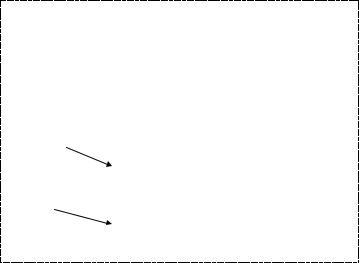
A Chinese Interactive Feedback System for a Virtual Campus
Figure 9. Node data structure |
|
|
|
|
|
|
|
|
|||||
|
|
|
|
|
|
|
|
|
|
|
|
|
|
|
|
|
|
|
|
|
|
|
|
Result of |
|||
|
|
|
|
|
|
Context |
|||||||
|
|
|
|
|
|
|
database |
||||||
|
|
|
|
|
|
|
|
|
|
searching |
|||
|
|
|
|
|
|
|
|
|
|||||
|
|
|
|
|
|
|
|
|
|
|
|
|
|
|
|
|
|
|
|
Length |
|
up-connection |
|
||||
|
|
|
Array of |
|
|
|
|
||||||
|
|
|
|
|
|
|
|
|
|
|
|
|
|
|
|
|
POS |
|
|
|
|
|
|
|
|
|
|
|
|
|
|
|
|
|
|
||||||
|
|
|
|
|
|
|
|
|
|
|
|
|
|
|
|
|
|
|
|
|
|
|
|
|
|||
|
down-connect |
|
|
|
|
|
|
|
|
|
|||
|
ion array |
|
|
|
|
|
|
|
|
|
|||
|
|
|
|
|
|
|
|
|
|
|
|
|
|
Context-Proofreading System
This system uses the segmentation tree built in the corpora-comparing system to evaluate the context according to the grammar recorded in the grammar principle database. This system deletes segmentation sub-trees which are not matched with the grammar and decides the POS which the lexical entry belongs to. When proceeding with the grammar proofreading, the system only compares the POS of the front lexical entry rather than proofreading the whole article so that the system can determine the POS of the lexical entry in the oral language conversation more correctly while increasing speed and flexibility of the judgment.
The main reason for adopting the method of judging the relationship of the grammar between the front and rear words is that grammar structure is usually not perfect in an oral language conversation. If the system uses only grammar rules it would find errors in determining the
POS. In contrast, if the system checks only the relationship between the front and rear words, it would correctly determine the POS. The detailed procedure is shown in Figure 10.
Weighted-Calculation System
The weighted-calculation system is used to judge thecorrectnessof segmentationresultswhenthere is morethanoneresultaftergrammaranalyzation, as a segmented Chinese sentence may have more than one suitable way for splitting. This system computes the weights according to the lexical entry building principle, with the segmentation result having the largest weight being the correct one. The process of the weighted calculation is listed as follows:
Weight=Weightsoflength*Weightsofsearch-
ing result * Word frequency
A.Weights of length: The longer lexical entry has a higher priority according to the lexical entry-building principle. Therefore, the longer the length the larger the weight .
B.Weight of searching result: The weight of the searching result changes based on whether this word is an unknown word or not. In principal, the weight of a known word is larger than that of an unknown word. However, according to the principle
298
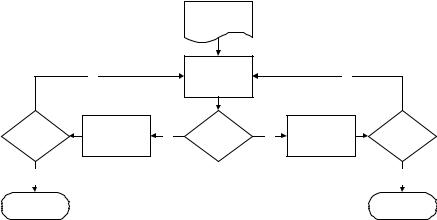
A Chinese Interactive Feedback System for a Virtual Campus
Figure 10. The flow chart of the keyword in context comparing system
Segmentation
tree
|
Y |
|
move pointer |
|
Y |
|
|
|
|
to sub-tree |
|
|
|||
|
|
|
|
|
|
||
have |
record |
|
fit in with |
|
delete this |
have |
|
un-search |
Y |
N |
un-search |
||||
analysis result |
grammar |
sub-tree |
|||||
sub-tree |
|
|
sub-tree |
||||
|
|
|
|
|
|||
N |
|
|
|
|
|
N |
|
finish analyze |
|
|
|
|
|
finish analyze |
of long lexical entry privacy, the system sets the weight of an unknown word to be the same as N-continuous words. Therefore, the weight of an unknown word is only slightly larger than a one-continuous known word.
C.Word frequency: Shows how often the lexical entry appears in the equilibrium corpora. The more often the lexical entry appears, the higher frequency it has.
After calculating the weighted sum of all nodes on every branch the system can find the segmented result that is the most suitable for the lexical entry-building principle.
Syntactic Analysis System
The main function of the syntactic analysis system is to transform the lexical entries of the input sentence into a structure that can represent the relationship of these lexical entries. However, not all the input sentences are legal in syntax, and the system should provide a fault-tolerance mechanism.Withafault-tolerancemechanism,the system can tolerate common mistakes in general oral conversation and thereby increase the level of fluency in the conversation. Figure 11 shows the flowchart of the syntactic analysis system which utilizes the “Word-based Link Grammar” (Slea-
tor & Temperley, 1991) as the parsing method of the syntax.
Word-Based Link Grammar
The method of the Word-based Link Grammar definesthelinkingrulesoneachlexicalentryfor making the link relations. The syntactic analysis system obtains the relations as the syntactic parts of each lexical entry. Table 3 shows the linking rules of each part of speech.
When the syntactic analysis system starts analyzing, it obtains the linking rules of each lexical entry from a dictionary and makes a link according to these linking rules. The parsing algorithm is shown as Algorithm 1.
Fault-Tolerance Mechanism
The sentences that have a syntax error usually appear in oral conversations and those sentences that are difficult to parse. Therefore, it is necessary for the syntactic analysis system to provide a fault-tolerance mechanism. The proposed syntactic analysis system provides the fault-tolerance mechanism by modifying the linking rules of interrelated lexical entries. Figure 12 shows an example of fault-tolerance processing by omitting
the preposition  .
.
299
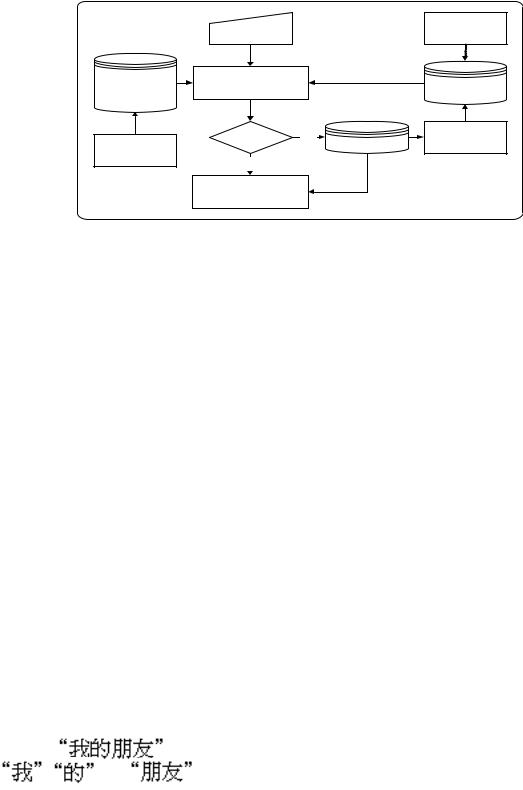
A Chinese Interactive Feedback System for a Virtual Campus
Figure 11. Flowchart of the syntactic analysis system
|
Segmented |
|
|
Identify of |
|
|
|
|
user |
||
|
sentence |
|
|
||
|
|
|
|
||
Link grammar |
Fault-tolerance |
|
|
Special error |
|
rules and |
syntactic parser |
|
|
||
general error |
|
|
rules |
||
|
|
|
|||
rules |
|
|
|
|
|
Definition of |
Legal in |
no |
|
Adjustment of |
|
syntax |
Error log |
error rules |
|||
general error |
|
||||
|
|
|
|
||
rules |
yes |
|
|
|
|
|
Semantic analysis |
|
|
||
|
system |
|
|
|
|
Table 3. The linking rules of each part of speech
part of speech |
linking rules |
|
|
|
|
Noun(N) |
(S+ or O-)&(Q- or())&(@Adjor ())&(Door ())&(Ds+ or |
|
|
())&(Cn1+ or ())&(Cn2or ()) |
|
Personal pronoun(Pa) |
(S+ or O-)&(@Adj- or ())&(Ds+ or ())&(Cn1+ or ())&(Cn2or ()) |
|
Demonstrative(Pb) |
(Bs+ or Pq+) |
|
Doubt pronoun(Pc) |
(S+ or O-) |
|
Quantifier (Q) |
(numor Pqor (Pq- & num-))&(Q+) |
|
Adjective(Adj) |
(Adj+ or Bj-)&(Adva- or ())&(Nojor ())&(Ca1+ or ())&(Ca2or |
|
()) |
||
|
||
Adverb-decorate adjective(Adva) |
(Adva+) |
|
Adverb-decorate verb(Advb) |
(Advb+) |
|
Negation(No) |
(Noj+ or Nov+) |
|
Auxiliary verb(Hv) |
(Hv+) |
|
Transitive verb(Vt) |
(Hvor ())&(S-)&(O+)&(Advb- or()) |
|
Intransitive verb(Vi) |
(Hvor ())&(S-)&(Advb- or()) |
|
Preposition(D) |
(Ds- & Do+) |
|
Conjunction(C) |
(Ca1- & Ca2+)or(Cn1- & Cn2+) |
|
|
(Bsor S-)&(O+ or ())&(Bj+ or ()) |
|
Indicative(Bv) |
|
|
|
|
In the first block of Figure 12, after the segmentation system process, the correct Chinese
sentence |
|
is segmented into |
, |
, and |
and their parts |
of speech are “Pa”, “D”, and “N” respectively. The system obtains the linking rules of each lexical entry from the dictionary and checks if the linkage of each lexical entry is correct. However, in the second block of Figure 12, because of the omis-
300

A Chinese Interactive Feedback System for a Virtual Campus
Algorithm 1. Syntactic analysis system
Comment:
Sentence: sentence inputted by user Token: segmented lexical entry
First_Token: first lexical entry of sentence
Last_Token: last lexical entry of sentence
Token_Link: flag of whether the lexical entry is linked or not
Link_Grammar: linking rules of lexical entry Disjuncts: linking rules in disjunctive form
Syntactic_Error: syntactic error flag
Right_Links: right connectors of linking rules Left_Links: left connectors of linking rules Syntactic_Part: syntactic part
Syntactic_Error_Procedure: procedure when errors exist on syntax BEGIN
get Tokens of Sentence segmented by the segmentation system END
BEGIN
FOR(i=First_Token to Last_Token)
BEGIN
set Token_Link off
get Link_Grammar of the ith Token from Dictionary make Disjuncts of the ith Token
END
set Syntactic_Error off
FOR(i=First_Token to Last_Token)
BEGIN
FOR(j=next Token of the ith Token to the Last_Token and exist Right_Links)
BEGIN
IF(one of jth Token's Left_Links matches one of ith Token's Right_Links) THEN BEGIN
1.make a link between the ith and the jth Token and assign Syntactic_Part 2.set both ith and jth Token's Token_Link on
3.remove the Disjuncts of the ith Token and the jth Token that are without a link 4.remove this link from the Disjuncts of the ith Token
END END
IF(ith Token's Token_Link=off) THEN
BEGIN
set Syntactic_Error on END
END
IF(Syntactic_Error=on) THEN
BEGIN
call Syntactic_Error_Procedure() END
END
sion of preposition |
, the sentence can not |
|
make a connection between lexical entry |
||
and |
by means of the linking rules. |
|
Therefore, in the last block of Figure 12, with the defining of error linking rules “Err_D”, the
lexical entry  and
and  can make
can make
a connection by linking rules “Err_D” so as to provide the fault-tolerance processing.
Semantic Analysis System
The semantic analysis system, as shown in Figure 13, transforms the structure of the sentence, as constructed by the syntactic analysis system,
301

A Chinese Interactive Feedback System for a Virtual Campus
Figure 12. Fault-tolerance processing with omitting of the preposition
Figure 13. Flowchart of the semantic analysis system
Result of syntactic analysis
Responsion |
no |
Is there any |
yes |
Get the verb |
|
|
system |
verb |
|
|
|||
|
|
|
|
|
||
|
|
|
|
Get subject and |
|
|
Semantic |
|
|
|
object around the |
|
|
|
|
|
verb |
|
|
|
meaning |
|
|
|
|
|
|
|
|
|
|
|
|
|
|
|
Semantic |
|
Semantic |
|
Concept |
|
|
concept |
|
parsing |
|
sequence |
|
|
hierarchy |
|
|
|
database |
|
yes |
|
|
Is legal in |
no |
|
|
|
|
semantic |
Error log |
||
|
|
|
|
|
into the semantic meaning. The system judges the correctness of the semantics and provides a semantic learning method based on the user’s oral habits.
Because the judgment of semantics only determines the correctness of the subject and the object around the verb, the proposed system searches for the verb of a sentence in advance. If
there is no verb in the sentence, the system will continue to the next sub-system after retaining the semantic meaning in the semantic network. The parsing algorithm of semantics is shown as Algorithm 2.
302
A Chinese Interactive Feedback System for a Virtual Campus
Algorithm 2. Semantic analysis system
Comment:
Token: lexical entry
First_Token: first lexical entry of asentence
Last_Token: last lexical entry of a sentence Syntactic_Part: syntactic part
Verb: the verb of a sentence Subjective_Token: the lexical entry of a subject Objective_Token: the lexical entry of a object Verb_Token: the lexical entry of a verb
Semantic_Error_Procedure: the procedure when an error exist in the semantics Semantic_Network: semantic network
BEGIN
FOR(i=First_Token to Last_Token)
BEGIN
IF(exist Token which Syntatic_Part is a Verb) THEN BEGIN
search Subjective_Token and Objective_Token that is related to this Verb_Token check semantics between Subjective_Token and Verb_Token
check semantics between Verb_Token and Objective_Token IF(semantics is not illegal) THEN
BEGIN
call Semantic_Error_Procedure() return
END
according to Subjective_Token, Verb_Token and Objective_Token create Semantic_Network END
END
FOR(i=First_Token to Last_Token)
BEGIN
IF(Token isn't in Semantic_Network) THEN BEGIN
insert the Token into the Semantic_Network according to the link END
END END
Memory-Based Parsing System
The proposed system utilizes the “Memory-based parsing system” (Chung & Moldovan, 1994b) as the parsing method of the semantics. There are three parts in the memory-based parsing system: the concept sequence layer, the semantic concept hierarchy, and the instance layer.
Concept Sequence Layer
The concept sequence layer keeps both the syntactic and the semantic restrictions of the subject and the object around the verb. As shown in Figure 14, the concept sequence layer takes the verb as the principal element. The verb element links to
both the subject and the object elements via the pointers to obtain their restrictions. The detailed contents are explained as follows:
•Structure of the verb:
Lexical entry of the verb: Save the context of the verb.
S: Link to the restriction of the subject.
O: Link to the restriction of the object.
Time: Link to the parts of the sentence regarding time.
Place: Link to the parts of sentence regarding place.
Sentence: Link to the sub-sentence.
•Structure of the subject or the object:
303
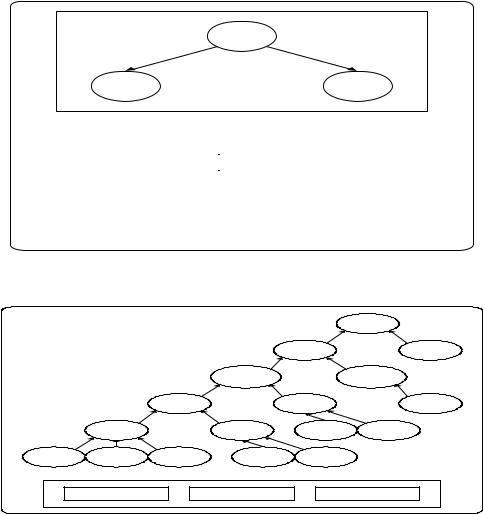
A Chinese Interactive Feedback System for a Virtual Campus
Figure 14. Structure of the concept sequence layer
Structure of
concept sequence Verb layer
|
Subject |
|
|
|
|
|
|
|
|
Object |
|
|
||
Structure of verb |
|
|
|
|
|
|
|
|
|
|
|
|
||
|
|
|
|
|
|
|
|
|
|
|
|
|
|
|
|
Lexical entry |
|
|
|
|
|
|
Link |
|
|
|
|
|
|
|
of verb |
|
S |
|
O |
Time |
|
Place |
|
Sentence |
|
|||
|
|
|
|
|
|
|
|
|
|
|
|
|
|
|
Structure of subject or object |
|
|
|
|
|
|
|
|
|
|
|
|
||
|
|
|
|
|
|
|
|
|
|
|
|
|
|
|
|
Syntactic restriction |
|
|
Ellipsis |
|
|
|
|
Link |
|
|
|||
|
|
|
|
|
|
flag |
|
|
|
Lexical entry or |
|
|||
|
Semantic restriction |
|
|
|
|
|
|
|
|
sentence |
|
|||
|
|
|
|
|
|
|
|
|
||||||
|
|
|
|
|
|
|
|
|
|
|
|
|
|
|
Figure 15. Structure of semantic concept hierarchy
|
Semantic concept |
|
|
|
Object |
|
hierarchy database |
|
|
|
|
|
|
|
|
Entity |
Abstract |
|
|
|
Creature |
|
Non- |
|
|
|
|
Creature |
|
|
|
Animal |
|
Plant |
Stone |
|
Human |
|
Non- |
Flower |
Grass |
|
|
Hunan |
|||
You |
Me |
Teacher |
Cat |
Dog |
|
Structure of node |
|
|
|
|
|
|
ID |
|
Lexical entry |
ID of parent |
|
Syntactic restriction: Record the restricsemantic restrictions but also a basis of encoding
tion of the syntax.
Semantic restriction: Record the restriction of the semantics.
Ellipsis flag: For judging whether the subject or the object element can be omitted.
Lexical entry or sentence: Link to the actual lexical entry or sub-sentence of the subject or the object.
Based on the structure of the concept sequence layer,thesystemprovidesnotonlyverificationof
of the input sentence.
Semantic Concept Hierarchy
The semantic concept hierarchy defines the relation of the nouns according to the meaning of the nouns. The semantic restrictions of subject and object in the concept sequence layer directs them to get their restrictions via the pointers. The structure of the semantic concept hierarchy is shown in Figure 15. The detailed contents are explained as follows:
304
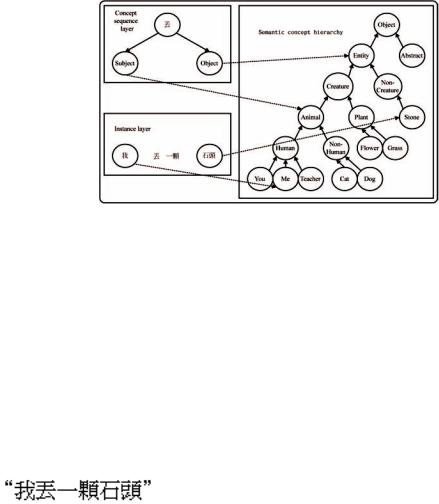
A Chinese Interactive Feedback System for a Virtual Campus
Figure 16. Example of semantic verification
•ID: Store the identity number of the noun.
•Lexical entry: Store the context of the noun.
•ID of parent: Keep up-link of the parent’s ID.
Instance Layer
In the instance layer, the proposed system records thelexicalentries andobtainsthe semanticrestrictions from the concept sequence layer by comparing the lexical entry of the verb with the verb elements in the concept sequence layer. Figure 16
takes asanexamplefor parsing by the above three layers. Because each lexicalentryofsubjectandobjectcouldfindapath to reach their semantic restrictions, the example sentence is legal. The parsing path of the subject
is “ |
|
” and the path of the |
object is “ |
|
”. |
Learning mechanism of Semantics
In the procedure of semantics processing there could be some inconsistency between the system and the user. Because of this problem, the system should provide a learning mechanism (Kim &
Moldovan, 1995) for reducing the differences between the system and the user. The proposed
learning mechanism is divided into two parts: generalization and specialization.
Generalization
Generalization of the learning mechanism loosens the semantic restrictions. Figure 17 shows examples of generalization:
There are two conditions of generalization when differences appear between the system and the user:
•Therestrictionlayerofthesystemisgreater and equal to the restriction layer considered by the user, as shown on the left side of Figure 17. Should the user decide that one of the oblique nodes should be corrected, the system would find the lowest common parent node (meshed node) of the oblique node and the restriction node (black node) as the new restriction.
•The restriction layer of the system is less than the restriction layer considered by the user as shown on the right side of Figure 17. If the user decides that the meshed node on top of the restriction node (black node) shouldbecorrected, this meshednodewould become the new restriction node.
305
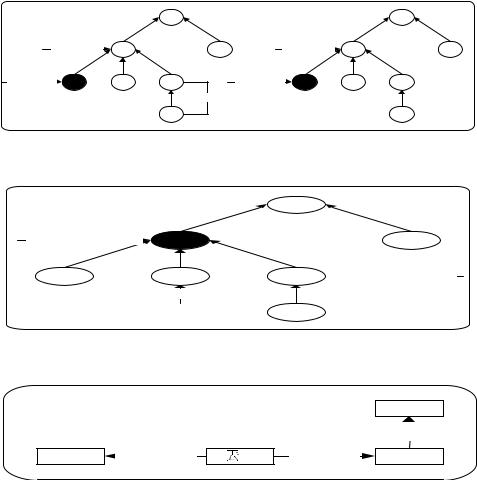
A Chinese Interactive Feedback System for a Virtual Campus
Figure 17. Generalization
New restriction |
New restriction |
Old restriction |
Old restriction |
|
or |
Figure 18. Specialization
Old restriction
 New restriction
New restriction
New restriction
Figure 19. An example of semantic network
instance-of
|
subject |
object |
|
Specialization
Specialization of the learning mechanism shrinks the semantic restrictions. Figure 18 shows an example of specialization.
If a user decides that one of the nodes (oblique node) under the restriction node is illegal in semantics, the system would change the restriction by eliminating all the illegal nodes under the restriction node and the meshed nodes would become the new restriction nodes, as shown in Figure 18. If the illegal node considered by the user is above or the equal to the restriction node, the system would ask the user what the restriction should be.
Semantic Network
The purpose of the semantic network (Quillian, 1968) is to store and represent the meaning of semantics so as to apply it in the inference mechanism. The semantic network describes the relationship between an object and an event. There are three elements in a semantic unit: entity, attribute, and value:
•Entity:Theprincipalpartofasemanticunit that represents an object or event.
•Attribute:Anarcthatdescribestheattribute of the entity.
306
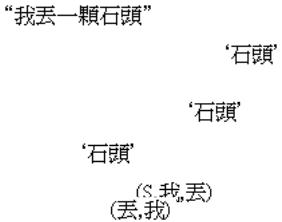
A Chinese Interactive Feedback System for a Virtual Campus
•Value: The result of the attribute that describes the entity.
F i g u r e 19 u s e s t h e s e n t e n c e as an example. The meshednodeisoneofthenodesintheconcepthier-
archy layer, and the actual lexical entry
in the instance layer uses the arc of the attribute
‘instance-of’toformasemanticunitofsemantic
network with the concept node . With the link of the attribute ‘instance-of’ the actual
lexical entry inherits the property or the capability from the concept node. The system
transforms the linkage |
into the se- |
manticunitsubject |
.Consequently,the |
unit of semantic network is established through linkage by the syntactic parser.
Response System
In the past, learners have had to know exact keywords when using a search engine. However, two identical keywords in different contexts produce different meanings and therefore return different, sometimes undesirable, results. For example, “tell meaboutthespecificationsofBluetooth”and“tell me about the applications of Bluetooth,” although having the same keyword, have different meanings.Thefirstsentenceconcernshardwarespecifications of Bluetooth, and the second, software applications of Bluetooth. Learners then would have to filter the data from the results by themselves. The Bayesian Network(BN) and Natural Language Understanding(NLU) (Arai, Wright,
Riccardi, & Gorin, 1998; Carpenter & ChuCarroll, 1998; Kuhn & De Mori, 1995; Miller & Bobrow, 1994; Pieraccini&Levin,1992)are used to decipher ambiguous sentences and evaluate the searching preferences of different learner.
Before attempting to develop a system, the applicationdomainshouldbedefinedasitisvery difficult to solve problems of uncertain domain.
The application domain of the proposed system
is set to the basic computer concept. As shown in Figure 20, understanding natural language queriesforaspecificapplicationdomaininvolves parsing the input query into a series of domainspecific keywords and searching for the goal of the learner’s query. A searching goal assumes that within a restricted application domain, there is a finite set of semantic keywords (M) as well as a finite set of searching goals (N). The searching goals SGi and keywords Ki are all binary decisions, and the keyword Ki is true if it appears in the speech. In this way, the proposed system can formulate the NLU problem by making M binary decisions with N BNs. The BN for the searching goal SGi takes the input as a set of keywords K extracted from the learner’s query. The BN then gives a posterior probability P(SG | K) for the binary decision. The connection of the BN assumes conditional independence among the set of keywords K, meaning that there are direct links between the goal and the concept nodes and no linkages among the concepts nodes. This is equivalent to a naïve Bayes formulation.
When applying the Baysian rule the proposed system assumes that the searching goal SGi is present if P(SG | K) is greater than a threshold θ or absent otherwise. θ may be set to 0.5 for simplicity because P(SGi =1|K)+P(SGi =0|K) is equal to 1. This formula provides a method to reject out-of-domain queries(OODQ). A query is classified as OODQ when all BNs vote negative for their corresponding goals. Assuming that the searching sentence contains i keywords denoted by KWi , every keyword affects the searching goal. The searching sentence can be represented as Figure 20 and Formula 1.
According to the Minimum Description Length (MDL) principle, every node in the BN provides the complexity of the network by a
magnitude of Lnetwork. Lower values for the Lnetwork reflectlowernetworkcomplexities.Eachnodealso
provides the accuracy in modeling the data by a magnitude of Ldata. Lower values for Ldata reflect higher accuracy. In this way, the total description
307
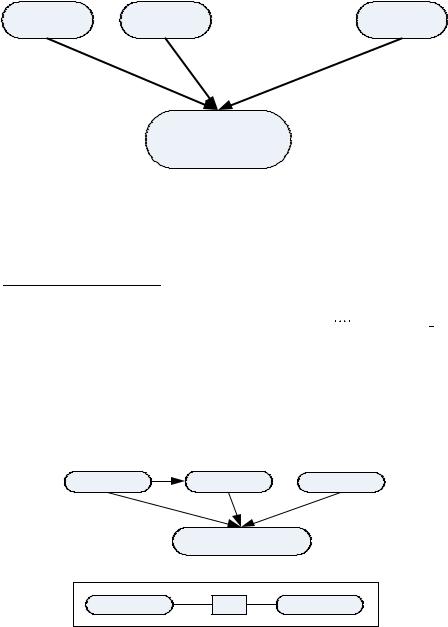
A Chinese Interactive Feedback System for a Virtual Campus
Figure 20. Belief network of keywords and searching goal
Keyword_1 Keyword_2 ……… Keyword_n
Searching Goal
Formula 1.
P(SG | KW1, KW2 ,...., KWn ) 
P(KW1, KW2 ,...., KWn , SG)
P(KW1, KW2 ,...., KWn )

 P(KW1, KW2 ,...., KWi )P(KW2 | KW1 )P(KW3 | KW2 ) P(KWn | KWn 1 )
P(KW1, KW2 ,...., KWi )P(KW2 | KW1 )P(KW3 | KW2 ) P(KWn | KWn 1 )
(1)
KW1, KW2, …., KWn : search keywords
SG : Searching Goal
Figure 21. Trained topology of BN and keyword groups
Keyword_1 |
Keyword_2 |
Keyword_3 |
Searching Goal
SG, K1, K2 |
SG |
SG, K3 |
length Ltotal providedbythegivennodeisdefined by Ltotal = Lnetwork + Ldata. The total description length of a network is the sum of all the concept
nodes in the network. The trained BN topologies is shown in Figure 21. There are two keyword groups (maximal sets of nodes that are all pairwise linked)—(SG, K1, K2) and (SG, K3) which
show that the keyword groups can communicate through the separator node SG. Each keyword group Ki relates to a joint probability P(SG, Ki). The keyword group (SG, K1, K2) relates to the joint probability P(SG, K1, K2), and the keyword group (SG, K3) relates to the joint probability P(SG, K3). Given a learner’s query, the proposed
308

A Chinese Interactive Feedback System for a Virtual Campus
Formula 2.
* |
|
|
* |
|
|
|
P* (K ) |
P |
(SG , K ) |
P(SG |
| K )P |
(K ) |
P(SG |
, K ) |
|
|
|||||||
|
i |
i |
|
|
i |
|
P(K) |
|
|
|
|
|
|
|
(2)
P*(K): Initialized by the presence or absence of the concepts in the learner’s query.
P(SGi, K) : Joint probability obtained from the training set. P*(SGi, K) : Updated joint probability.
* : Denotes an updated probability with knowledge about the presence or absence of the various concepts in the learner’s query.
Formula 3.
P* (K, SG ) |
P(K | SG )P* (SG ) |
P(K, SG ) |
P* (SG ) |
||
i |
|||||
P(SG ) |
|||||
i |
i |
i |
i |
||
|
|
|
|
i |
|
(3) P*(SGi) : Updated from instantiating the searching goal node.
P(K, SGi): Joint probability of the keyword group obtained from the training set. P*(K, SGi): Updated joint probability of the keyword group.
system derives the presence and absence of the various keywords K and updates the joint probability according to Formula 2. The updated joint probability is eventually marginalized to produce a probability for the searching goal P*(SG).
The BN framework from NLU is extended to mixed-initiative dialog modeling. The idea is to enable BNs to automatically detect missing or spuriouskeywordsaccordingtodomain-specific constraints captured by their probabilities. If a missing keyword is detected, the BN prompts the dialog to display the necessary information to the learner. If a spurious keyword is detected, the BN prompts the dialog to notify the learner regarding the unnecessary information. Automatic detection of missing and spurious keywords is achieved by the technique of backward inference which involves probability propagation within the BN. Considering the inferred searching goal SGi
for a given learner’s query, the goal node of the corresponding BN is instantiated (to either 1 or 0) to test the network’s reliability in each of the input keywords. If the BN topology is assumes conditional independence among the keywords, the updated probability of the concepts would be P(Kj | SG). However, in the proposed BN in which the keywords depend on each other, the updated searching goal probability P*(Ki) would propagate to update the joint probabilities of each keyword group P*(Ki , SGi). In this way, each P*(Kj) can be obtained by marginalization. This procedure is described by Formula 3 and is similar to the procedure described by Formula 2 for updating concept probabilities.
BasedonthevalueofP*(Kj),thesystemmakesa binarydecision(bythresholdθ)regardingwhether
Kj should be present or absent. This decision is compared with the actual occurrence of Kj in
309
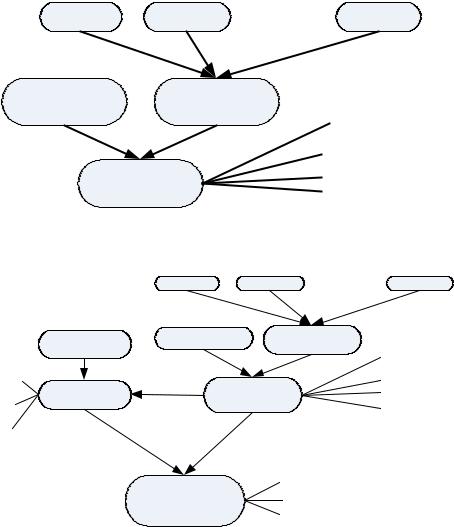
A Chinese Interactive Feedback System for a Virtual Campus
Figure 22. Bayesian network of knowledge domain
Keyword_1 Keyword_1 …… Keyword_n
Browse record |
Searching Goal |
|
|
|
Hardware |
|
|
Software |
Knowledge |
Network |
|
. |
||
|
Domain |
. |
|
|
. |
Figure 23. Bayesian network of teaching material difficulty
|
|
Keyword_1 |
Keyword_1 |
…… Keyword_n |
|
|
Examination |
Browse Record |
Searching Goal |
||
|
Difficulty |
|
|
|
Hardware |
Excellent |
Examination |
|
Knowledge |
Software |
|
|
|
. |
|||
Good |
Result |
|
Domain |
|
Network |
|
|
. |
|||
Poor |
|
|
|
|
. |
|
|
|
|
. |
|
|
|
|
|
|
|
|
|
Teaching Material |
Hard |
||
|
|
Normal |
|||
|
|
Difficulty |
|
||
|
|
|
Basic |
||
|
|
|
|
||
the learner’s query. Should the binary decision indicate that Kj is absent and it appears in the input query, the keyword is labeled spurious and the dialog would invoke an explanation. If the binary decision indicates that Kj should be present but it is absent from the query, the keyword is labeled missing and the dialog would invoke the prompting act.
Using keywords andsearchinggoals to categorize knowledge domains is not always desirable as some learners just browse casually in which case a wider variety of search results is preferred.
Therefore, the system records browsing habits as another factor that affects the knowledge domain. The corresponding BN is shown as Figure 22 and the probability is described by Formula 4.
The last part is to determine the content and degree of the response to learner. The learning results could be judged by some type of test where a high score indicates a good learning effect and a low score indicates a poor learning effect. The modifiedBNisshownasFigure23andtheprobability is described by Formula 5 and 6.
310

A Chinese Interactive Feedback System for a Virtual Campus
Formula 4.
P(KW | BR, SG) |
P(BR | KW , SG)P(KW | SG) |
|
P(BR | SG) |
||
|
(4)
P(KD|BR,SG): Probability of knowledge domain
P(BR): Probability of learner’s browse record.
P(SG): Probability of searching goal.
Formula 5.
P(ER | ED, KD) |
P(ED | ER, KD)P(ER | KD) |
|
P(ED | KD) |
||
|
(5)
P(ER|ED,KD): Probability of examination result.
P(ED): Probability of examination difficulty.
P(KD): Probability of knowledge domain.
Formula 6.
P(TMD | ER, KD) |
P(ER | TMD, KD)P(TMD | KD) |
|
P(ER | KD) |
||
|
(6)
P(TMD|ER,KD): Probability of teaching material difficulty.
P(ER): Probability of examination result. P(KD): Probability of knowledge domain.
EXPERImENTAL RESULTS
The implementation uses the following example sentence  to describe the process of each step.
to describe the process of each step.
Segmentation System
The segmentation system divides the example sentence into lexical entries and gives each lexical entry a suitable part of speech as follows. Figure
24 shows the list branching from the first to the fourth layer. Table 4 shows the segmentation table of sentence in Figure 24
The segmentation system divides the example sentence into lexical entries and gives each lexical entry a suitable part of speech as follows:
:Demonstrative pronoun [Pb]
:Quantifier [Q]
:Noun [N]
311
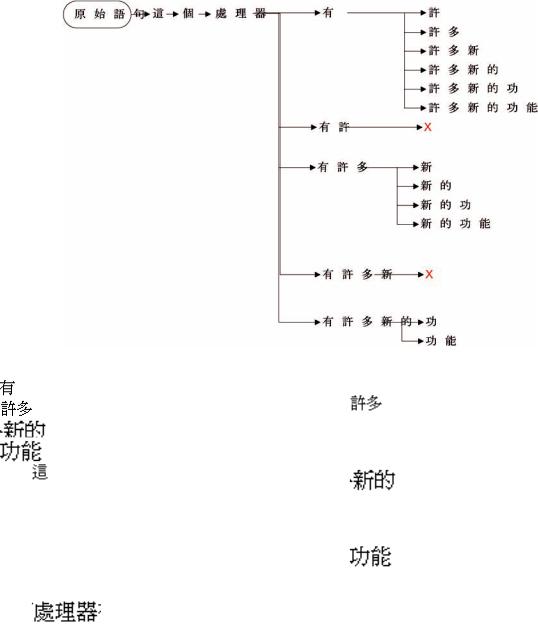
A Chinese Interactive Feedback System for a Virtual Campus
Figure 24. List of separating from the first layer to the fourth layer
:Transitive verb [Vt]
:Adjective [Adj]
:Adjective [Adj]
:Noun [N]
1.: (Bs+ or Pq+)
(()(Bs))
 (()(Pq))
(()(Pq))
2. : (numor Pqor (Pq- & num-))&(Q+)
((num)(Q))
((Pq)(Q))
((Pq,num)(Q))
3. :(S+orO-)&(Q-or())&(@Adj- or ())&(Door ())&(Ds+ or ())&(Cn1+ or ())&(Cn2or ())(1)
(({Q},{@Adj},{Do},{Cn2})(S,{Ds},{Cn1}))
((O,{Q},{@Adj},{Do},{Cn2})({Ds},{Cn1}))
4.  : (Hvor ())&(S-)&(O+)&(Advb- or())
: (Hvor ())&(S-)&(O+)&(Advb- or())
((S)(O))
((Hv,S)(O))
((S,Advb)(O))
((Hv,S,Advb)(O))
5. |
:(Adj+orBj-)&(Adva-or())&(Noj- |
|
or ())&(Ca1+ or ())&(Ca2or ()) |
(({Adva},{Noj},{Ca2})(Adj,{Ca1})) |
|
((Bj,{Adva},{Noj},{Ca2})({Ca1})) |
|
6. |
:(Adj+orBj-)&(Adva-or())&(Noj- |
|
or ())&(Ca1+ or ())&(Ca2or ()) |
(({Adva},{Noj},{Ca2})(Adj,{Ca1})) |
|
((Bj,{Adva},{Noj},{Ca2})({Ca1})) |
|
7. |
: (S+ or O-)&(Q- or())&(@Adj- |
|
or ())&(Door ())&(Ds+ or ())&(Cn1+ or |
|
())&(Cn2or ()) |
(({Q},{@Adj},{Do},{Cn2})(S,{Ds},{Cn1}))
((O,{Q},{@Adj},{Do},{Cn2})({Ds},{Cn1}))
After obtaining the above linking grammars, the system begins to parse the sentence according to the above algorithm. The linking process of the first and second lexical entries are shown in Figure 25.
Because the first lexical entry contains only its relation to the second lexical entry with the
312

A Chinese Interactive Feedback System for a Virtual Campus
Table 4. The segmentation table of sentence
START |
STRING |
WORD |
RESULT |
|
|
|
|
Start at C(1) |
|
|
|
|
|
|
|
|
C(1) |
|
O |
|
|
|
|
|
C(1)_ C(2) |
|
X |
|
|
|
|
|
C(1)_C(2)_C(3) |
|
X |
|
|
|
|
|
C(1)_C(2)_C(3)_C(4) |
|
X |
|
|
|
|
|
C(1)_C(2)_C(3)_C(4)_C(5) |
|
X |
|
|
|
|
|
C(1)_C(2)_C(3)_C(4)_C(5)_C(6) |
|
X |
|
|
|
|
Start at C(2) |
|
|
|
|
|
|
|
|
C(2) |
|
O |
|
|
|
|
|
C(2)_ C(3) |
|
X |
|
|
|
|
|
C(2)_C(3)_C(4) |
|
X |
|
|
|
|
|
C(2)_C(3)_C(4)_C(5) |
|
X |
|
|
|
|
|
C(2)_C(3)_C(4)_C(5)_C(6) |
|
X |
|
|
|
|
|
C(2)_C(3)_C(4)_C(5)_C(6)_C(7) |
|
X |
|
|
|
|
Start at C(3) |
|
|
|
|
|
|
|
|
C(3) |
|
X |
|
|
|
|
|
C(3)_ C(4) |
|
X |
|
|
|
|
|
C(3)_C(4)_C(5) |
|
O |
|
|
|
|
|
C(3)_C(4)_C(5)_C(6) |
|
X |
|
|
|
|
|
C(3)_C(4)_C(5)_C(6)_C(7) |
|
X |
|
|
|
|
|
C(3)_C(4)_C(5)_C(6)_C(7)_C(8) |
|
X |
|
|
|
|
|
|
|
|
|
|
|
|
|
|
|
|
313
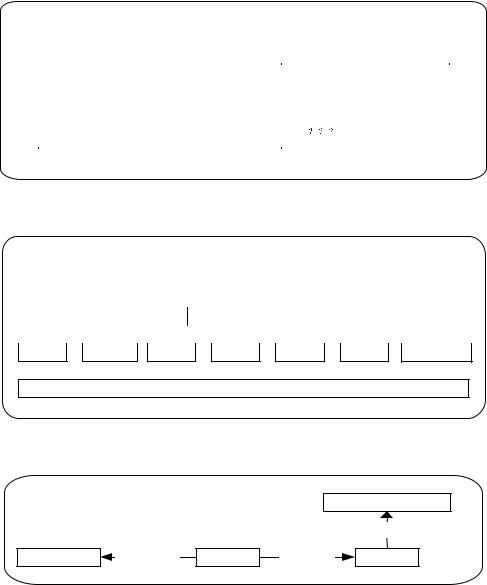
A Chinese Interactive Feedback System for a Virtual Campus
Figure 25. Process of syntactic analysis
|
|
|
|
|
|
|
|
|
|
|
|
|
|
|
|
|
|
|
|
|
|
|
|
|
|
I |
|
|
|
|
|
|
|
|
|
|
|
|
|
|
|
|
I |
|
|
|
|
|
|
|
|
|
|
|
|
|
|
|
|
|
|
|
|
|
|
|
|
Lexical |
|
|
|
|
|
|
|
Linking |
|||||||
|
|
|
Lexical |
|
|
|
|
|
|
Linking |
|
|
|
|
|
|
|
D |
|
|
entry |
|
|
|
|
|
|
|
result |
|
|||||||||||
|
D |
|
|
|
entry |
|
|
|
|
|
|
|
|
result |
|
|
|
|
|
|
|
|
|
|
|
|
|
|
|
|
|
||||||||||
|
|
|
|
|
|
|
|
|
|
|
|
|
|
|
|
|
|
|
2 |
|
|
|
|
|
|
|
|
|
|
True |
|
|
|
||||||||
|
1 |
|
|
|
|
|
|
|
|
|
|
|
|
True |
|
|
|
|
|
|
|
|
|
|
|
|
|
|
|
|
|
|
|
|
|||||||
|
|
|
|
|
|
|
|
|
|
|
|
|
|
|
|
|
|
|
|
|
|
|
|
|
|
|
|
|
|
|
|
|
|
|
|
|
|||||
|
|
|
|
|
|
|
|
|
|
|
|
|
|
|
|
|
Pq |
|
|
|
|
|
|
Disjunctions |
|
|
|
|
|
|
|
|
|||||||||
|
|
|
|
|
Disjunctions |
|
|
|
|
|
|
|
|
|
|
|
|
|
|
|
|
|
|
|
|
|
|
|
|||||||||||||
|
|
|
|
|
|
|
|
|
|
|
|
|
|
|
|
|
|
|
|
|
|
|
|
|
|
|
|
|
|
|
|
|
|
||||||||
|
|
|
|
(()( |
|
Pq )) |
|
|
|
|
|
|
|
|
|
|
|
|
|
|
(( |
Pq )( |
Q |
)) |
|
|
|
|
|
||||||||||||
|
|
|
|
|
|
|
|
|
|
|
|
|
|
|
|
|
|
|
|
|
|
|
|
|
|
|
|
|
|
|
|
|
|
||||||||
|
|
|
|
|
|
|
|
|
|
|
|
|
|
|
|
|
|
|
|
|
(( Pq |
, num |
)( |
Q )) |
|
|
|||||||||||||||
|
|
|
|
|
|
|
|
|
|
|
|
|
|
|
|
|
|
|
|
|
|
|
|
|
|
|
|
|
|
||||||||||||
|
|
|
|
|
|
|
|
|
|
|
|
|
|
|
|
|
|
|
|
|
|
|
|
|
|
|
|||||||||||||||
|
|
|
|
|
|
|
|
|
|
|
|
|
|
|
|
|
|
|
|
|
|
|
|
|
|
|
|
|
|
|
|
|
|
|
|
|
|
|
|
|
|
|
|
|
|
|
|
|
|
|
|
|
|
|
|
|
|
|
|
|
|
|
|
|
|
|
|
|
|
|
|
|
|
|
|
|
|
|
|
|
|
|
|
|
|
|
|
|
|
|
|
|
|
|
|
|
|
|
|
|
|
|
|
|
|
|
|
|
|
|
|
|
|
|
|
|
|
|
|
||||||
|
|
|
|
|
|
|
|
|
|
|
|
|
|
|
|
|
|
|
|
|
|
|
|
|
|
|
|
|
|
|
|
|
|
|
Linking table |
||||||
|
|
|
|
|
|
|
|
|
|
|
|
|
|
|
|
|
|
|
|
|
|
|
|
|
|
|
|
|
|
|
|
|
|
|
|||||||
|
|
|
|
|
I |
|
Lexical |
|
|
|
|
|
Linking |
|
|
|
|
|
|
|
|
|
|
|
|
|
|
|
|||||||||||||
|
|
|
|
|
D |
|
|
|
entry |
|
|
|
|
|
result |
|
|
|
|
|
|
|
|
|
|
|
|
|
|
|
|
( Pq , 1 , 2 ) |
|||||||||
|
|
|
|
|
3 |
|
|
|
|
|
False |
|
|
|
|
|
|
|
|
|
|
|
|
|
|
|
|
|
|
|
|
|
|
||||||||
|
|
|
|
|
|
|
|
|
|
Disjunctions |
|
|
|
|
|
|
|
|
|
|
|
|
|
|
|
|
|
|
|
|
|
|
|
|
|
||||||
|
(( |
{ Q |
} ,{ @ Adj |
|
},{ Do |
} ,{ |
Cn |
2 } )( S ,{ |
Ds |
} ,{ |
Cn |
1 } )) |
|
|
|
|
|
|
|
|
|
|
|
|
|
|
|
|
|||||||||||||
|
(( |
O ,{ |
Q } ,{ @ |
Adj |
},{ |
Do |
} ,{ |
|
Cn 2 } )( { Ds |
} ,{ |
Cn |
1 } )) |
|
|
|
|
|
|
|
|
|
|
|
|
|
|
|
|
|||||||||||||
|
|
|
|
|
|
|
|
|
|
|
|
|
|
|
|
|
|
|
|
|
|
|
|
|
|
|
|
|
|
|
|
|
|
|
|
|
|
|
|
|
|
Figure 26. Result of the syntactic analysis
|
|
|
|
|
|
|
|
|
|
|
|
|
|
|
|
|
|
|
|
|
|
|
|
|
|
|
|
|
|
O |
|
|
|
|
|
|
|
|
|
|
|
|
|
|
|
|
|
|
|
|
|
|
|
|
|
|
|
|
|
|
|
|
|
|
|
|
|
|
|
|
|
|
|
|
|
|
|
|
|
|
|
|
|
|
|
||
|
|
|
|
|
|
|
|
|
|
|
|
|
|
|
|
|
|
|
|
|
|
|
|
|
|
|
|
|
|
|
|
|
|
|
|
|
|
|
|
|
|
|
|
|
|
|
Pb |
|
|
|
|
Q |
|
|
|
S |
|
|
|
|
|
|
|
|
|
|
|
Adj |
|
|
|
|
|
|
|
|
|||||||||||
|
|
|
|
|
|
|
|
|
|
|
|
|
|
|
|
|
|
|
|
|
|
|
|
|
|
|
|
|
|
|
|
|
|
|
|
|
|||||||
|
|
|
|
|
|
|
|
|
|
|
|
|
|
|
|
|
|
|
|
|
|
|
|
|
|
|
|
|
|
|
|
|
|
|
|
|
|
|
|
|
|
||
|
|
|
|
|
|
|
|
|
|
|
|
|
|
|
|
|
|
|
|
|
|
|
|
|
|
|
|
|
|
|
|
|
|
|
|
Adj |
|
|
|
|
|
|
|
|
|
|
|
|
|
|
|
|
|
|
|
|
|
|
|
|
|
|
|
|
|
|
|
|
|
|
|
|
|
|
|
|
|
|
|
|
|
|
|
||||
|
|
|
|
|
|
|
|
|
|
|
|
|
|
|
|
|
|
|
|
|
|
|
|
|
|
|
|
|
|
|
|
|
|
|
|
|
|
|
|
|
|
|
|
|
|
|
|
|
|
|
|
|
|
|
|
|
|
|
|
|
|
|
|
|
|
|
|
|
|
|
|||||||||||||||||
|
|
|
|
|
|
|
|
|
|
|
|
|
|
|
|
|
|
|
|
|
|
|
|
|
|
|
|
|
|
|
|
|
|
|
|
|
|
|
|
|
|
|
|
The |
used |
disjunctions of each lexical entry |
: |
|
|
|
|
|
|
|
|
|
|
|
|
|
|
|
|
|
|
|
|||||||||||||||||||||
(()(Pq )) |
|
((Pq)(Q)) |
|
(()(S)) |
|
((S)(O)) |
|
(()(Adj)) |
|
|
(()(Adj )) |
|
((O,@Adj )()) |
||||||||||||||||||||||||||||||
Linking result :Pq,1,2 Q,2,3 S,3,4 O,4,7 Adj,5,7 Adj,6,7
Figure 27. Semantic network of example sentence
,
characteristic
subject |
|
object |
linking requirement ‘Pq’, the linking results of the first and second lexical entries are set to true and it records the linkage ‘(Pq,1,2)’ in the linking table. The linkage ‘(Pq,1,2)’ denotes that the firstlexicalentryconnectsleftwardtothesecond lexical entry via the connector ‘Pq’. The linking result of the third lexical entry is still false as a resultofhavingnorelationshipwiththefirstlexi-
calentry.Thefinalresultofthesyntacticanalysis is shown in Figure 26.
Semantic Analysis System
After the syntactic analysis procedure, the system can determine that the fourth lexical entry is a verb and that the third and seventh lexical entries are the subject and object, respectively, accord-
314
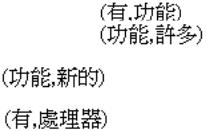
A Chinese Interactive Feedback System for a Virtual Campus
ing to linkages (S,3,4) and (O,4,7). The system determines the correctness of the semantics, and the sentence is classified as legal if it conforms to semantic restrictions. Finally, it transforms these linkages into semantic meanings as shown in Figure 27:
•(S,3,4)subject
•(O,4,7)object
•(A d j , 5 ,7 ) c h a r a c t e r i s t i c
•(A d j , 6 ,7 ) c h a r a c t e r i s t i c
CONCLUSION AND FUTURE WORK
This paper applies the linking of grammar to describe the syntactical construction of sentences and proceeds to verify and record the semantics according to the construction. At the end, the proposed system replies to the user by finding the suitable response derived from the response database.Accordingtotheimplementationresults, the proposed system could correctly describe the relationship between lexicons. Furthermore, with the use of memory-based parsing, the proposed system can check the correctness of the semantics and provide a learning mechanism by changing the semantic restrictions of the concept sequence layer. Finally, by classifying the response databases and using the verb of the sentence as the search key, the response system greatly reduces theamountofresponseresultsandincreasesspeed and accuracy. Of the numerous possible applications in the future, one could further develop the interaction between computer and user by utilizing user characteristics and habits, allowing the proposed method to generate a variety of improved responses. With the continual progression of the computing age and the increasing need for improved methods of automated communication,
the future of the proposed system remains both worthwhile and practical.
REFERENCES
Arai,J.,Wright,G.,Riccardi,&Gorin,A.(1998).
Grammar fragment acquisition using syntactic and semantic clustering. The 4th International Conference on Spoken Language Processing.
Carpenter, B. & Chu-Carroll, J. (1998). Natural language call routing: A robust, self-organizing approach. The 4th International Conference on Spoken Language Processing.
Chen, J.-F., Lin, W.-C., Jian, C.-Y. (2003a). Using the keyword in context segmentation method for collaborative design in a Chinese Web site. The 10th ISPE International Conference on Concurrent Engineering: Research and Applications, pp. 967–975.
Chen, J.-F., Lin, W.-C., Jian, C.-Y., Ho, T-.Y., &
Dai, S.-Y. (2003b). Using the keyword in context segmentation method foraChineseWebsite. 2003 International Conference on Computer-Assisted Instruction, National Taiwan Normal University, Taipei, Taiwan, pp. 74-80.
Chen, J.-F., Lin, W.-C., Jian, C.-Y., & Hung,
C-.C. (2003c). A Chinese automatic interactive feedback system for applying in a Web site. The Second International Human.Society@Internet Conference, pp.238-248.
Chen,J.-F.,Lin,W.-C.,Jian,C.-Y.,&Hung,C-.C.
(2005). A Chinese interactive feedback system for an e-learning Web site. Journal of Information Science and Engineering, 21(5), 929-957.
Chen,K.J.,&Liu,S.H.(1992).Wordidentification for mandarin Chinese sentences. Proceedings of the Fifteenth International Conference on Computational Linguistics, Nantes, pp.101-107.
315
A Chinese Interactive Feedback System for a Virtual Campus
Chung,M.&Moldovan,D.(1993).Parallelmem- ory-based parsing on SNAP. Parallel Processing Symposium,ProceedingsofSeventhInternational Conference, pp. 680-684.
Chung,M.&Moldovan,D.(1994a).Applyingparallel processing to natural-language processing.
IEEE Expert [see also IEEE Intelligent Systems], 9(1), 36-44.
Chung, M. & Moldovan, D. (1994b). Memorybased parsing with parallel marker-passing.
ProceedingsoftheTenthConferenceonArtificial
Intelligence for Applications, pp. 202-207.
Kim, J-.T. & Moldovan, D.I. (1993). Acquisition of semantic patterns for information extraction from corpora. Proceedings of Ninth Conference on Artificial Intelligence for Applications, pp.171-176.
Kim,J-.T.&Moldovan,D.I.(1995).Acquisitionof linguistic patterns for knowledge-based information extraction. IEEE Transactions on Knowledge and Data Engineering, 7(5), 713-724.
Kuhn, R. & De Mori, R. (1995). The application of semantic classification trees for natural language understanding. IEEE Trans. Pattern Anal. Machine Intell., 17, 449-460.
Miller, S. & Bobrow, R. (1994). Statistical language processing using hidden understanding models. The Human Language Technology Workshop, 278-282.
Pieraccini, R. & Levin, E. (1992). Stochastic representation of semantic structure for speech understanding. Speech Communication, 11, 283288.
Quillian, M.R. (1968). Semantic Memory. In
Semantic information processing, pp. 216-270. Cambridge, MA: MIT Press.
Sleator, D. & Temperley, D. (1991). Parsing English with a link grammar. Carnegie Mellon University Computer Science technical report CMU-CS-91-196.
This work was previously published in International Journal of Distance Education Technologies, Vol. 6, Issue 4, edited by S. Chang; T. Shih, pp. 62-90, copyright 2008 by IGI Publishing (an imprint of IGI Global).
316
